HUMAN SERVICES COMMITTEE MINUTES – OCTOBER 15, 2019
JAMES J. ROWLEY, VICE CHAIR
MEMBERS PRESENT: Dr. Chase, Mr. Bush, *Mr. Jordan
MEMBERS ABSENT: Mr. Buckel
ALSO ATTENDING: Chairman Knapp; See attached list
Vice Chair Rowley called the meeting to order at 10:00 a.m. A motion was made by Dr. Chase, seconded by Mr. Bush to waive the reading and approve the minutes of the previous committee meeting. Passed unanimously; MOTION CARRIED.
1. HILLBROOK: Damian Pratt, Director of Juvenile Justice; Ann Rooney, Deputy County Executive - Human Services
a. Informational Update
Ms. Rooney:
- County Raise the Age plan was approved Friday afternoon
- No youth at Hillbrook unless Judge remands them there; County has no power to say yes or no to youth
- Hillbrook under NYS Office of Children and Family Services (OCFS)
- Raise the Age youth is under OCFS as well as the Commission of Corrections
- Dual license and certification - everything do is authorized by state; no different than running the detention center
- Youth could come from Family Court or the new youth part
*Mr. Jordan arrived at the meeting.
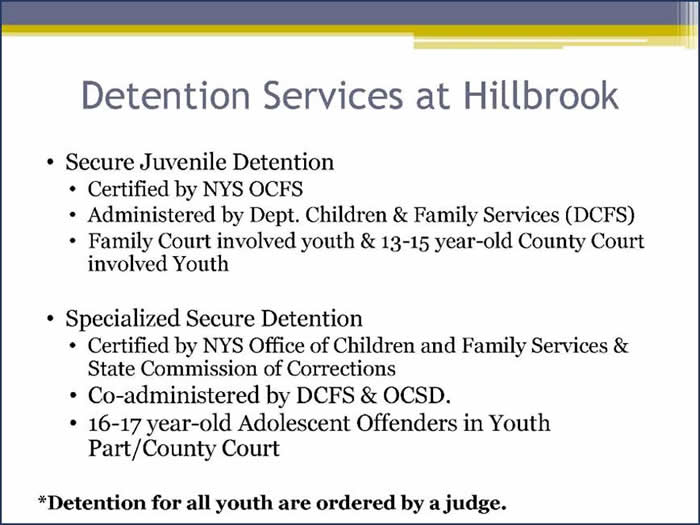
Mr. Pratt:
-
Legislation created 2 separate detention facilities under one roof; Hillbrook is one building, but there are 2 programs being run: Secured Detention and Specialized Secure Detention
-
Secure Detention for youth going to Family Court, or those under age of 16 being prosecuted at Criminal Court due to the severity of their offense (i.e. firearms, murder 2)
-
Specialized Secure Detention – newly created specifically for adolescent offenders (ages 16 or 17) that come through the new youth part of Criminal Court
-
Building currently split in half – (2) 8 bed units for Secure Detention; (2) 8 bed units for Specialized Secure Detention
-
Difference in operation is state oversight: Secure Detention is overseen by OCFS; Specialized Secure has dual oversight with OCFS and NYS Commission of Corrections
-
Responsibility of local Sheriff’s Department to provide inspection security reports
-
Do have discretion for taking youth from out of county – want youth to be at same type of level as the youth they accept in Onondaga County
-
Current total capacity is 32; 16 Secure & 16 Specialized Secure Detention – currently 28 youth as of this morning
Ms. Rooney added that with the capital improvements the capacity goes to 50. Vice Chair Rowley asked when it will be done. Ms. Rooney responded that the plan is approved, so they are shooting for the end of next year, or the beginning of 2021. Mr. Pratt commented that they hope to break ground in the next six weeks. It is a complicated project, because it is a secure facility with six overall phases. They will establish a new perimeter first, then work from the outside in. The expanded areas will be able to be built and created without entering the facility, and they will break through at the end. As of today there are 28 young people, so Mr. Pratt explained that they are not in a position to close any sections.
Dr. Chase asked for a breakdown of the ages of the 28 youth. Mr. Pratt referred to the slides, stating that 17 year olds were affected two weeks ago. The next slide shows the analysis of who is in the building, and which youth is deemed RTA versus the traditional population.
 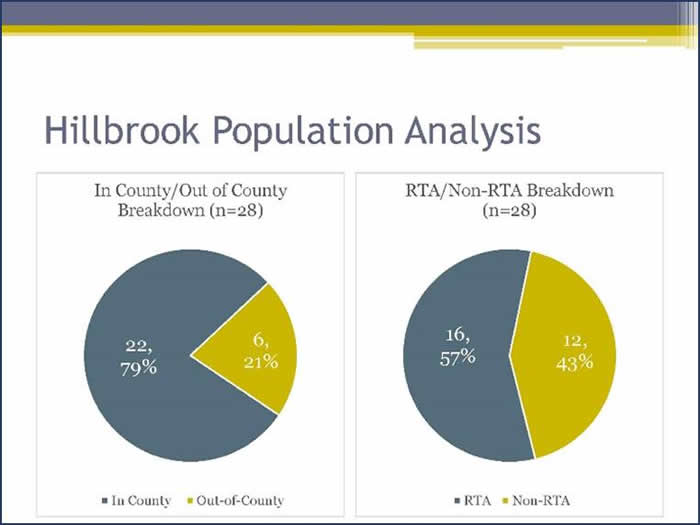
-
State requirements not about age, but what court they are in; adolescent offenders at ages 16 or 17 in Criminal Court automatically start in Specialized Secure
-
If that case does not involve a serious injury, weapon or sex offense, then the presumption is that it will move to Family Court, and the youth is moved to Secure Detention
-
(i.e.) 16 year old comes in with robbery offense; youth could have charges moved to Family Court; Hillbrook has to release them from Specialized Secure Detention, and re-enroll in traditional Secure Detention
-
Normally classify units based on age, physical size, maturity, cognitive function and educational needs – new legislation prevents breaking up the youth in the safest way; continue to advocate to state why this does not make sense
Ms. Rooney added that they can make decisions based on the criteria Mr. Pratt listed for girls, but for boys it is straight down the line. Mr. Pratt said they had one girl last week who was moved to non-secure detention.
Mr. Pratt continued that they have the highest volume of 16 year olds, and most jurisdictions that have gone through RTA have seen a reduction in their younger youth population. The three 13 year olds are in on very serious offenses.
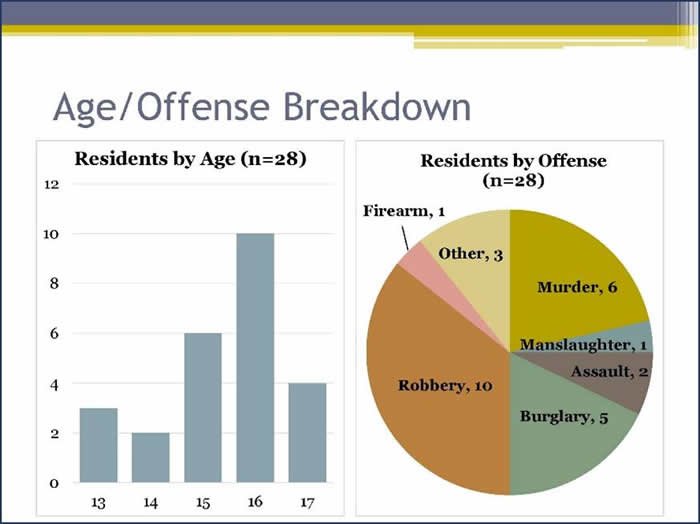
- 2 with lower level offenses – (1) out of county youth; (2) 1 small and multiple serious offenses (ultimately long term removal from community)
Vice Chair Rowley asked if the County is compensated for the out of county youth at Hillbrook. Mr. Pratt responded that the state reimburses the County 100% for all costs associated with their detention. Vice Chair Rowley wanted clarification that it is the County’s costs driving the rate versus a formula. Mr. Pratt explained that there is a formula that establishes the daily rate: ~$900 per day for Secure Detention, and ~$1,700 per day for Specialized Secure. Rates are set and established by the state taking into consideration all the costs of the facility. Specialized Secure costs more due to increased staffing. Vice Chair Rowley asked if these rates are reasonable, and Mr. Pratt answered yes; they work with the state by providing all expense lines.
Mr. Bush asked how much the capital expense is for the renovations, and Mr. Pratt replied that they are estimating $5 million; 100% reimbursable.
Mr. Jordan asked if they will be sending out for an RFP on the plans, and Ms. Rooney responded that they already did. The $5 million is a firm number. Mr. Pratt commented that several contractors have been selected and will be ready to go when the planning phase is done. Mr. Pratt answered Vice Chair Rowley that the reimbursement is via debt service. Mr. Pratt said all expenses that were requested by Probation, Sheriffs and Children and Family Services have been approved for full reimbursement. Vice Chair Rowley explained to Mr. Bush that right now the County is being reimbursed, but that could change. Ms. Rooney agreed.
Mr. Pratt clarified for Dr. Chase that the Specialized Secure youth does not have contact with the other youth. It has to be completely separated, and they cannot intermix any groups. (i.e.) The social work hallway for attorney and family visits cannot have youth from both detention settings at the same time; so visits for one population is a different day than for the other. Phone calls and social work department visits are all separate. A youth may move to different units based on the court, but otherwise the youth do not have contact. Mr. Pratt replied to Dr. Chase that the same staff is dealing with both.
Mr. Bush asked if those in the same detention setting interact, and Mr. Pratt said yes.
Dr. Chase asked how those in Specialized Secure Detention get along with each other. Mr. Pratt answered that the dynamics of any group of people living in close quarters is challenging; especially teenagers. Dr. Chase said that is dangerous, and Ms. Rooney commented it is the nature of what they do running Hillbrook. Mr. Pratt stated that if they asked Chief Gonzalez how many incidents happen at the Justice Center (16 and 17 year olds) versus Hillbrook, it would be significantly less at Hillbrook. It is partially due to the layout of the building and smaller class sizes. Two years ago there was a pod of 30-40 young people with one Sheriff Deputy (at the Justice Center), which is a more unsafe situation. Dr. Chase asked if the staff are safe. Mr. Pratt explained:
- Building broken up into 3 departments: Childcare Staff (responsible for 24 hour care for safety and security); Education Department (teachers and assistants); Social Work Department (Social Workers and licensed Master Social Worker)
- Youth are never alone in the building without Childcare staff present (including with teachers and social workers)

- Therapeutic Crisis Intervention (TCI) - Behavior Management System utilized; required by state regulations
-
Focus on verbal de-escalation and also physical interventions, when necessary; Hillbrook has lowest rate of physical interactions compared to Erie and Monroe counties
-
Educational staff and social work staff go through TCI to get verbal de-escalation techniques; in the event of physical intervention, do not want social workers or education staff involved
-
Increase in requirements for frontline staff positions created for Specialized Secure regulations; previously staff needed at least 6 months experience working with youth in a school or detention center – now it’s 2 years’ experience
-
Legislation created need for Rapid Response Team – wanted individuals in those roles able to do the job
-
Majority of critical incidents are preventative - staff observant and can see escalation; fight does not have to happen;
-
Rapid Response team needs to be proactive to prevent critical incidents; specialized training to respond to crisis, as well as handling safety and security checks, room searches, keeping the building safe, etc.
Dr. Chase asked if there will be any changes to the oversight of youth when the amount of beds goes to 50. Mr. Pratt responded that there will be changes to the medical services contract including the need for medical personnel present 24 hours per day versus an on-call doctor. There is a requirement to have an additional Social Work Assistant, additional needs to Rapid Response and additions to the staff in general. Mr. Pratt said they are committed to TCI, so he does not see that changing. Ms. Rooney added that there will never be a time where the detention facility will be operated with guards like at the Justice Center or Jamesville. Anything coming from OCFS is meant to be therapeutic and restorative. Hillbrook is not a long term stay, but there will be some youth there for a time until their charges are adjudicated. They may move on to another OCFS facility or state prison. Mr. Pratt said that cases with violent crimes have adult sentencing requirements, and they go to the State Department of Corrections. It is a challenging population to deal with, but the staff is doing a tremendous job with young people that society does not want anything to do with. Staff having relationships with the residents is the best way to reduce critical incidents.
Vice Chair Rowley asked how involved the parents are with the youth. Mr. Pratt answered that some youth have strong parental support and others do not. Some youth are able to take Regents exams. (i.e.) There is a particular youth that has been at Hillbrook since December and excels at school; his mom advocates for him to keep going. Mr. Pratt explained that some youth do not have family visits or phone calls due to the family dealing with other challenges, or they do not have an identified parent. Currently there are five youth with no parent or legal guardian responsible for them.
Ms. Rooney suggested that it may be beneficial for the committee to tour the facility. Mr. Bush responded that the facility felt very sterile, and they only talked about what is going on. Mr. Pratt responded to Mr. Bush that they do not want the residents to feel like they are on display. There are a lot of programs and people that come in from the outside to offer a restorative justice program, yoga classes, boxing program, “I apologize” program, etc. Managing the environment is a big concern when young people have a high level of hopelessness.
Chairman Knapp asked what the impact will be on youth due to the criminal justice reform (no bail) starting January 1st. Mr. Pratt answered that it will be minimal. The Justice Center population of 16 and 17 year olds was around 20, and Hillbrook’s estimated number after RTA was 12; which is where they are at. Any reductions from bail reform have been experienced already, and may affect one or two residents a month. One young person who made bail over the weekend. Usually for the offenses the Hillbrook residents are in for, it should not have an impact, because the crimes would require bail. Mr. Pratt explained to Chairman Knapp that there are no low level offenses or misdemeanos; the youth are there for high level offenses.
Mr. Pratt stated:
-
Secure Detention used to be 1 staff per 8 residents; new legislation requires ratio of 1 staff per 6 residents, which is not truly 1, because later it explains that there has to be 2 staff present at all times
-
In full support of this regulation; better off with partner, because 1 person can be engaged, while 1 is observing
-
Additional staff present is better for residents and youth; plus new Rapid Response team, who do more than critical incidents; team allows them to have someone at front searching people more thoroughly
-
Rapid Response team is also in units and classrooms engaging youth; staff ratio 2 per unit, but times with more present
Mr. Jordan said if they have a 16 or 17 year old that’s 6’3 and 250 lbs, they would not be easy to restrain, and Mr. Pratt agreed. Engaging and creating relationships with the youth is what really stops situations from going bad. Hillbrook has staff that youth trusts to keep them safe, and the fights usually do not last more than 5 seconds after intervention. Mr. Bush asked what staff has for personal protection. Mr. Pratt answered that they use TCI training, proximity, redirection, managing environment, and restraining techniques with multiple staff. Mr. Bush asked if there are firearms on the campus, and Mr. Pratt said no. Law enforcement is not even permitted to bring firearms in; they must secure their weapons in their vehicle, or in gun lock up at Hillbrook. It is NYS law that firearms are not permitted past a certain point, and the state does not believe those will keep staff and/or residents safe. It may actually elevate situations quicker.
Mr. Pratt replied to Mr. Bush that he does not believe the policy makers have been in a facility for a long time; which is seen by the way the County is being forced to set up units without their own judgment. Twenty years ago there were PINS offenses, which is not the same level of safety. Mr. Bush asked if there are more serious offenses than in the past, and Mr. Pratt said they have had violent offenses for a long time. There were 17 admissions of juvenile offenders under 16 charged as adults back then, and last year Hillbrook had 18. There has not been a significant increase or decline, but the population is more concentrated now. Before there would be one youth with a serious offense, and six with low level offenses that would “water it down.” Now it is a concentration with every youth being there for a serious offense. The goal of Juvenile Justice Reform is intervention at the right time. The last thing they want is a low level offender mixed into the population they have now, because that could be extremely damaging to a young person. Detention is a traumatic experience, so they try to mitigate that. Mr. Bush asked where a 17 year old would go before, and Mr. Pratt stated the Justice Center; only new charges go to Hillbrook. Ms. Rooney explained that the levels of crimes by 17 year olds are typical of what the population has had for 20 years, so the ages are the only thing that’s new. Mr. Bush said the security is very different at the Justice Center. Ms. Rooney clarified that one deputy at the Justice Center would be responsible for 30 youth, and now it’s a minimal of two staff for every 6. Mr. Pratt added that the response time to a critical incident at Hillbrook is 15 – 20 seconds versus at the Justice Center trying to get through the pods, where a lot could go wrong.
Mr. Pratt said if anyone is interested in seeing the boxing program in action, or another presenter, then they are very welcoming of that.
2. SYCAMORE HOUSE: Richard Gasiorowski, Commissioner; Ann Rooney, Deputy County Executive - Human Services
a. Informational Update
Mr. Gasiorowski handed out the following:

Onondaga County Sycamore House
Program Type: Group Home
Site Address: 1704 South Salina Street, Syracuse, NY 13205
Number of Beds available to youth: Ten (10)
Mission Statement:
The Onondaga County Sycamore House will provide intensive community-based treatment services and programs that allow youth to be safe and supported to assist them in their successful transition back into their home, school, and community.
General Philosophy and Purpose:
Onondaga County will provide foster care services for up to ten (10) youth in a group home setting. The program will focus on multi-system involved youth and hard to place youth ages 12-21. Youth who enter the program will receive intensive service delivery and individualized plans to support their safety and success while in the group home. Onondaga County Department of Children and Family Services’ (DCFS) comprehensive System of Care will allow for integrated services from multiple divisions to support these youth.
Need for Program:
Onondaga County DCFS has been striving to increase permanency for youth in the foster care system. Within the past two years, two local high use residential programs have closed while Raise the Age has forced several other campuses to reduce their capacity. In addition, the County has seen an increase in the rejection rate of youth at in-state facilities which has forced the County to make alternative, or out- of-state, arrangements for several youth resulting in lower success rates for youth and higher costs to the County. A review of these cases reveals that these youth linger in care, do not connect to their home community, and often do not transition successfully to other services or systems (OPWDD, OMH, etc.). Due to the above mentioned circumstances, a local approach to intensive service provision is likely to yield better overall outcomes for these youth.
Program Overview:
The Sycamore House will be staffed by County employees with a 2:1 youth to staff ratio during daytime hours and a 3:1 youth to staff ratio during overnight hours based on OCFS regulations. A program director and clinician will be onsite to manage day to day operations and oversee case management. The County has partnered with the Salvation Army to provide case management services for all youth in the program. Community partners will also provide medical, behavioral health, and educational services and programming to all Sycamore House residents.

Onondaga County Department of Children and Family Services
Sycamore Group Home Frequently Asked Questions
Who is ensuring the County is following all the foster care policies and procedures in starting up this home?
-
Onondaga County will require an operating license from the New York State Office of Children and Family Services. In order to obtain that license, the County must create policy and procedure and work with the OCFS Regional Office on a myriad of regulations and requirements to ensure that the program meets regulations and best practice for the desired population being served. The County is meeting with OCFS regularly and submitting those policies and procedures and plans for approval.
What Agenc(ies) are involved in oversight of the program once the program is opened?
-
Once opened the County operated Group Home will be like all other foster care settings in the state, required to comply with monitoring from NYS OCFS. There will be regular site inspections, reviews of documentation and staff logs and a formal incident review process that is required to involve OCFS notification. In addition, the Group Home will also be required to have an annual recertification inspection and reissuing of the license every year in which OCFS reviews the program.
The program will also interact with the NYS Justice Center for Vulnerable People should there be any complaints from children or providers that see any issues with the youth in the program.
What type(s) of exclusionary criteria exist for the program?
-
Currently, we are working to obtain a license that will only limit the youth eligible for the program because of extreme sexually acting out behaviors, severe medical need which require around the clock medical care and low IQ. Youth with those needs will need a higher level of care to assist with their therapy, medical and educational needs.
What training will be provided to staff to support these youth?
- Staff will be trained in non-restraint techniques including Therapeutic Crisis Intervention and Collaborative Problem Solving. Both trainings are to support using de-escalation techniques and understanding how each child has an individual way of processing information and processing frustration and anger. These are both top tier training curriculums that are used in the county in other areas with great success. In addition to these behavioral and crisis trainings, staff members will also be trained in Mental Health First Aid, CPR, Documentation and Incident Report Writing, Implicit Bias, and required fire safety and emergency management protocols for the building.
What does the medical care for these youth look like?
How are these youth getting to school and educated?
-
For those youth that are still in school (some youth will be beyond school age), the Group Home will assist the youth in getting to and from school. Recent Foster Care regulations have changes which allow youth in foster care to continue attending their home school district when it is in their best interest. The program will work with local school districts on transportation to and from school and will also support youth in alternative programs achieve educational success. For those that are not in school, we will assist with GED attainment and also support in finding employment and assist them in the transportation to and from work until they can develop the independent skills to do that on their own.
What types of skills programs and activities will the youth receive in the program?
-
Each youth in the program will have an Individualized Care Management Plan (ICMP) which will be put together by the Group Home clinician with input from the child’s case worker, service providers, therapy workers and family. This plan will focus on overall medical, educational and pro-social and life skills development. We believe that these will be unique for each youth, but that there will also be universal skills that can be exhibited in the home for all youth (cooking, cleaning, paying bills, working, healthy activity, civic engagement, etc.).
In partnership with many of our community partners, each youth will be provided a skill builder who will assist the child, family and staff in following through on those individualized service needs for the child and to assist in more of a 1:1 capacity the life skills that the child is working toward (driver’s license, job applications and interviews, etc.)
What is the overall goal of the program?
-
Data shows that most of the youth that reach congregate level and are in that level of care at age 14 will stay in the foster care at least until they are 18. Many of these youth discharge themselves from foster care and return to the very homes and communities in which they were removed from without the skills to navigate their community successfully. This is because many of the placements that they are in are far away from their community. The goal of this program is to assist the child and their extended family to work toward reunification safely, but also provide youth the skills they need to transition out of care (home, a kinship resource or on their own) successfully with a job, a safe place to live and a plan.
Ms. Rooney:
-
100% idea of County Executive after explaining issues with older youth in foster care; difficult to place teenagers, because foster families want little kids
-
Some foster kids may have had issues at birth (i.e. abuse, neglect), so they have behavioral challenges or brain injuries
-
County contracts with voluntary agencies including Elmcrest (contract now terminated) - County was paying for beds, whether occupied for not; Elmcrest would refuse children at door for any issue deemed unfit or inadequate staff on hand
-
Teenagers are as big as adults and come with teenage issues; voluntary agencies are refusing youth, and 5 agencies closed over the years
-
Whether youth in agency or foster home, still under care of Department of Children and Family Services (DCFS)
-
Commissioner responsible for determining the best level of care for every youth; regardless of circumstances
-
County has gone further and further away to find placement for youth including Florida and Massachusetts
-
Started engaging with Salvation Army – location of home will be 1704 S. Salina St. (formerly women’s shelter); beautiful old home on bus route with 8 bedrooms - 1 bedroom is on first floor and handicap accessible
-
Renovating home to make place that looks and feel like a home and meet needs of youth
-
Salvation Army owns the home and County is renovating with the help of the Salvation Army
-
Program Contract with Salvation Army, who will do some life skills training and therapeutic intervention; because doing this on their own property, County is not paying rent, but occupying building based on contract
-
Salvation Army will pay for any capital expenditure the County does (i.e. painting exterior)
-
County will pay for program costs (i.e. adjusting space to accommodate teenagers)
Dr. Chase asked if most of the kids at the home will be teenagers, and Ms. Rooney responded ages 13 – 18. Depending on their status, a child could be there up until they are 21. Mr. Gasiorowski replied to Mr. Bush that the department is responsible for all foster youth through age of 21. At age 18, a foster youth will go to court every 6 months to decide if they want to continue in foster care or not. Mr. Gasiorowski stated they continue to teach youth life skills to move on successfully.
Ms. Rooney explained to Dr. Chase that the legislation passed says youth have the option to stay in their home school district and would be required to have transportation. If they do not choose their home district, then they will go to Syracuse City Schools, because of the location of the home. Mr. Bush said the home district has to transport them, and Ms. Rooney agreed.
Mr. Rowley said he has heard it is difficult to become a foster parent and asked if that is true. Mr. Gasiorowski disagreed and stated that they run continuous recruitment for foster care parents. If the parent(s) cannot make it to the 12 week class at Park Central Church, then the department will send trainers to their house to do the same training. Ms. Rooney said people may be saying that they are not getting placements for the age children they want.
Ms. Rooney replied to Dr. Chase that they are in the planning renovations stage, but the big part is the license from OCFS.
- Putting together policies and procedures; OCFS has walked through 3 times to ensure renovations will be licensed from electrical to exits, etc.
-
Having to follow regulations; OCFS a great partner allowing department to send policies and procedures as they are created; see the urgency of this as well
-
Already getting inquiries from several other counties; Onondaga County is not the only county having older youth getting rejected; it’s being explored by counties, because they do not have option of saying no
-
Excited to be pace setter; hoping to be open early next year; going through permitting with city
Ms. Rooney answered Mr. Bush that the license will be for 10 youth. Mr. Bush asked how many youth they have waiting to go into this home, and Mr. Gasiorowski said they have youth that are out of state they want to bring back and others at voluntary agencies they will bring in. There are at least 7.
Dr. Chase asked what happens when some are there for a long time and others come through. Ms. Rooney stated they have to find placement for all of them. They will still have a caseworker working on permanency to look for adoption options, etc.
Mr. Bush asked if it is coed, and Ms. Rooney said yes.
Mr. Jordan stated that the law emphasizes placing the youth with their biological family. Ms. Rooney commented that when youth come out of foster care, and their parents’ rights have been terminated, a great abundance will go back to their biological families.
Mr. Bush asked if they will have kitchen staff, and Ms. Rooney responded no. The youth will be doing that with staff to learn life skills including cooking, cleaning, laundry, etc. Mr. Gasiorowski added that they will be prepared for everything and will have basic life skills.
Mr. Bush asked where the staff will be coming from, and Ms. Rooney said the Legislature approved new positions in the budget. The criteria for hiring is similar to Hillbrook. There is part-time staff at Hillbrook that have been intensely trained in crisis intervention, so they will give opportunities to those at Hillbrook using it as a recruitment tool. Mr. Bush asked if they are civil service, and Ms. Rooney replied yes. Mr. Gasiorowski said there is a test, but there is no list at this point. Ms. Rooney explained to Mr. Bush that the staff will go through intense training. Dr. Chase added that they will go through a civil service test, and the best qualified will rise to the top.
Dr. Chase asked if the committee can come see it when it’s ready, and Ms. Rooney said absolutely. They will have a big opening.
Mr. Bush stated for the record, “I requested that the commissioner of Adult and Long Term Care come to our meeting to have a discussion on the Veterans Service Agency, and my request was not honored.” Vice Chair Rowley asked if he spoke with Mr. Buckel, and Mr. Bush said yes; he did not deny it.
The meeting adjourned at 10:59 a.m.
Respectfully submitted,

JAMIE M. McNAMARA, Assistant Clerk
Onondaga County Legislature
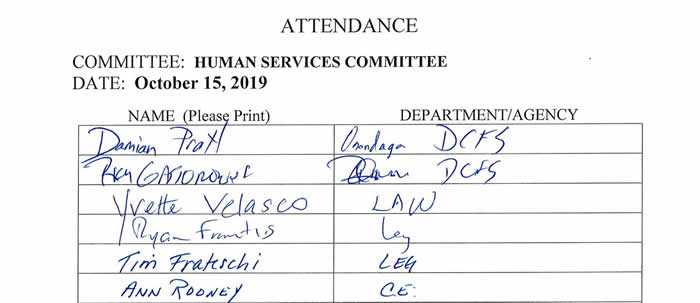
* * *
ENVIRONMENTAL PROTECTION COMMITTEE MINUTES – OCTOBER 16, 2019
CASEY E. JORDAN, CHAIRMAN
MEMBERS PRESENT: Mrs. Tassone, 2Mr. Bottrill, 1Mrs. Abbott-Kenan, 1Dr. Chase
ALSO ATTENDING: Chairman Knapp; see attached list
Chairman Jordan called the meeting to order at 9:04 a.m. A motion was made by Mrs. Tassone, seconded by Mr. Bottrill, to waive the reading of the proceedings from the previous committee. MOTION CARRIED. A motion was made by Mrs. Tassone, seconded by Mr. Bottrill, to approve the minutes of the previous committee meeting. MOTION CARRIED.
1. WATER ENVIRONMENT PROTECTION: Frank Mento, P.E., Commissioner; Benjamin Yaus, Senior Deputy County Attorney; Michael Lannon, P.E., Deputy Commissioner
a. Authorizing the Execution of a Settlement Agreement with Atlantic States Legal Foundation Regarding the Amended Consent Judgment (ACJ)
Mr. Mento:
- A very brief history of the ACJ
1Mrs. Abbott-Kenan and Dr. Chase arrived at the meeting.
-
ACJ has 2 requirements stormwater capture, which has been met, and water quality conditions of the tributaries that lead into the lake
-
Over the past 9 months, ASLF has negotiated their portion of the ACJ allowing us to work with the DEC under a 2 party agreement - effectively removing federal oversight of the project
-
More work needs to be done to satisfy DEC and meet the 2nd condition in the form of a Long Term Control Plan (LTCP)
-
The LTCP will provide the legal and technical instrument to get a variance on the water quality – simply put, if we get the variance we will have met both requirements of the ACJ
- ASLF, DEC, and WEP are all aligned on this settlement and the next steps
Chairman Jordan said that this gets us away from the actual litigation in federal court, and the LTCP is something that every county in the state has to deal with. Mr. Yaus stated that it is a requirement for having CSO’s. To be clear, this agreement itself does not remove us from the ACJ, we then have to petition the federal court. Discussions with the other parties and indications from the court are that if the ASLF is on board they are too. We have been 30 years under this order and have complied with every element; 2 tributaries have water quality issues that are largely unrelated to county discharges, which prevent us from technically being able to leave the ACJ.
In answer to Chairman Jordan, Mr. Yaus responded that he doesn't like to interpret what the court will do but doesn’t anticipate any difficulty. Chairman Jordan said that there have been some indications from the judge that he wants to get this off his plate. Mr. Yaus responded that after 30 years the court would like to see this off their docket. Mr. Mento stated we’ve heard that enough is enough.
Mrs. Abbott-Kenan stated that Onondaga Creek is one of the two tributaries, what is the other? Mr. Mento answered Harbor Brook, also Ley Creek.
Mrs. Abbott-Kenan said that not being able to meet the second requirement refers more to city situations in terms of it not being the normal situation of combined sewers. Mr. Mento responded that a lot of these tributaries flow from areas deep in the county, like Tully and Lafayette, where land uses have impacted what gets into them. The major point is that even if we abated all the CFO’s we would not meet the standard requirement. All realize this and that is why the time has come to settle this and move on with the LTCP.
Mrs. Abbott-Kenan asked the timeframe for satisfying the second requirement. Mr. Mento said that the LTCP is in the hands of the DEC for review and comment; probably have another 5 to 7 years’ worth of work. However, it is not at the scale, magnitude, and resource commitment of the past 30 years; severely reduced. Mr. Yaus stated that they hope to have a LTCP agreement by early 2020; this clears the biggest hurdle, the rest is technical details.
Chairman Jordan asked if they know what the elements of the LTCP would be. Mr. Mento answered that there are project, monitoring, and public outreach elements required under both federal and state statutes for the development of a LTCP. The majority is project-related but there are pieces that involve some monitoring, testing, verification, and a big piece on public information is embedded in the framework of what an LTCP should look like. Mr. Yaus stated that it is negotiating but there is a 5-year goal with projects continuing. The green infrastructure projects here will also be required under an LTCP so the agreement works out well for us.
Mr. Yaus stated that at this time he would like to discuss the proposed settlement of this ongoing litigation in an attorney-client setting if all agree.
A motion was made by Mr. Bottrill to go into executive session for the purpose of discussing pending litigation in the matter of Atlantic States Legal Foundation, et al v Onondaga County (88-CV-0066), and to discuss that matter on an attorney-client basis. Mrs. Abbott-Kenan seconded the motion. Passed unanimously; MOTION CARRIED.
A motion was made by Mr. Bottrill, seconded by Dr. Chase, to leave executive session and enter regular session. Passed unanimously; MOTION CARRIED.
For the record, Chairman Jordan said, “No action was taken during executive session.”
A motion was made by Mrs. Abbott-Kenan, seconded by Mr. Bottrill, to approve this item. Passed unanimously; MOTION CARRIED.
b. A Resolution Calling a Public Hearing in Connection with Proposed Improvements for the Onondaga County Sanitary District
Mr. Mento said that items 1b and 1c are public hearing resolutions that are part of the CIP projects for 2020 and beyond. Mr. Lannon does an excellent job each year with the CIP program and will discuss each of these projects.
Mr. Lannon:
- 1st project is combined sewer overflow 029 Walton Street abatement; highly active CSO, overflows into Onondaga Creek upwards of 40 times per year
- The project's intent is to reduce overflows to 4-6 times per year to comply with federal policy
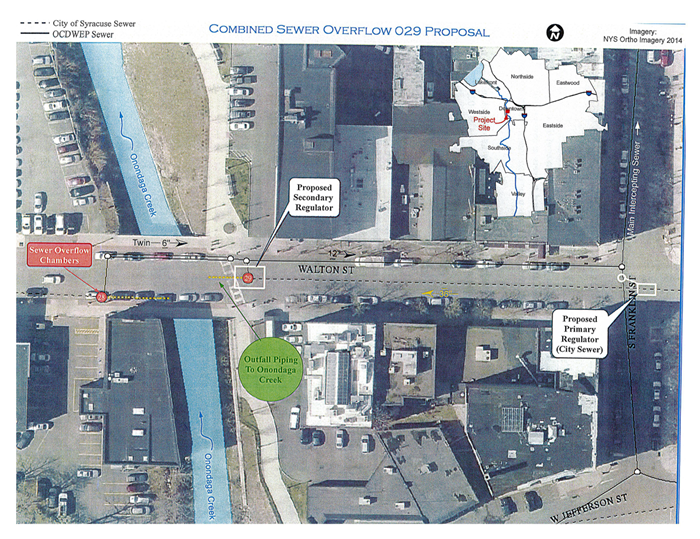
-
Flow normally goes down Walton Street (dotted line) to the 29 overflows (red circle 29), assuming low flow dry day it travels from right to left in a 36” pipe, then goes northward a little and flows into a 12” pipe, then right back literally in a circle; during high flows the 12” sewer can only take so much and excess overflows out of 29 into Onondaga Creek
-
Looking to make a more direct input into the MIS; installing the proposed primary regulator removes the circle so to speak and upsizes the pipe to 24 inches reduces the amount of flow into Onondaga Creek
-
Also, propose installing a secondary regulator with a rear wall to prevent the creek from coming back into the sewer at times; designed to meet federal requirements and CSO policy
Mr. Mento reiterated that it is a critical factor to go from 40 activations a year down to the standard 4-6. This is a very significant component of this project.
- Construction cost estimated at $2,020,000
Mrs. Tassone asked when the project would start and how long it will take. Mr. Lannon answered that it is currently in design and construction will probably start sometime next year. Mr. Mento said that the project would probably take one construction season but cautioned that it is in the middle of Armory Square.
Chairman Jordan asked the measures that would be taken to placate the business impact. Mr. Mento answered that a maintenance protection traffic plan for vehicles and business access will be part of the design.
A motion was made by Dr. Chase, seconded by Mr. Bottrill, to approve this item. Passed unanimously; MOTION CARRIED.
c. A Resolution Calling a Public Hearing for the Purpose of Considering an Increase in the Estimated Maximum Cost of Proposed Improvements for the Baldwinsville Treatment Plant
-
Phase II improvement for the Baldwinsville –Seneca Knolls WWTP, 3rd largest treatment plant, constructed in 1982, many original assets will be 40 years old by the time of construction
-
Project based on asset management evaluation; consulting firm identified CIP asset renewal in 5-year, 10-year, and 20-year horizons
-
The main thrust of the project is the rehabilitation of assets beyond their lifecycle, odor control improvements, and code compliance to maintain SPDES Permit and operational efficiencies
- Reviewed the following highlights:
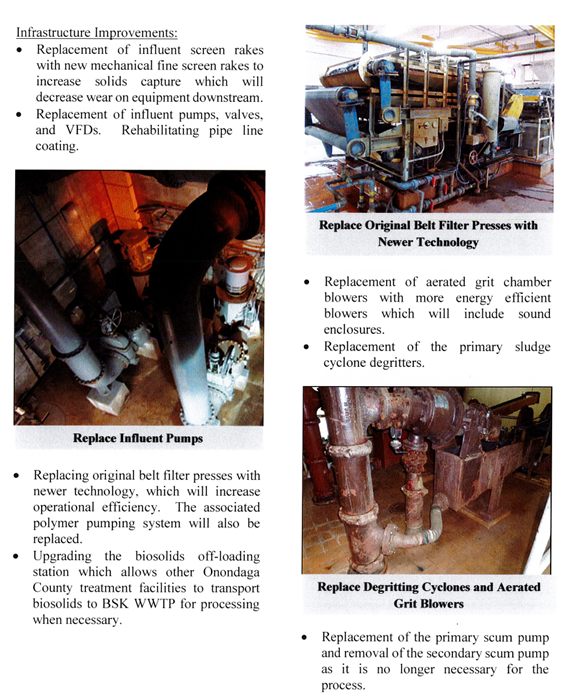 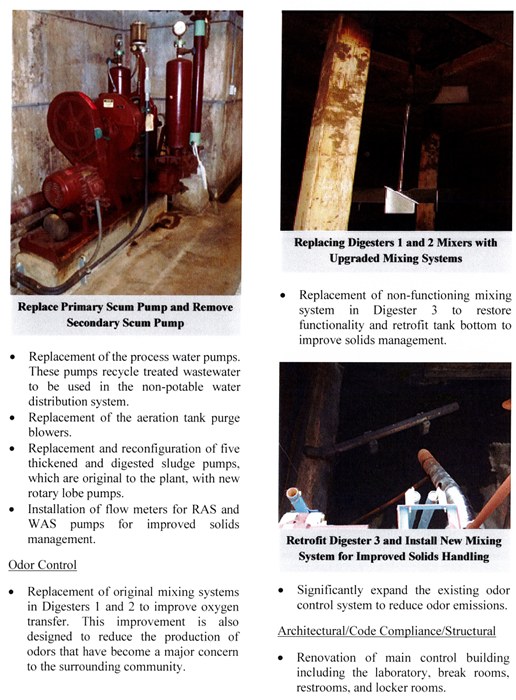
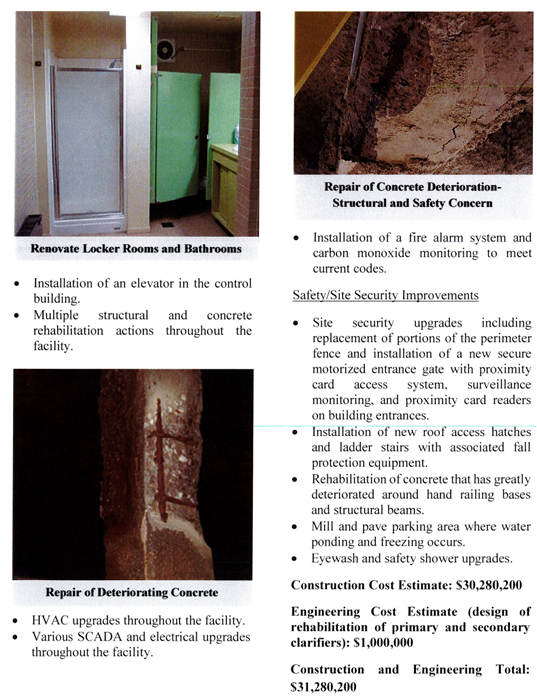 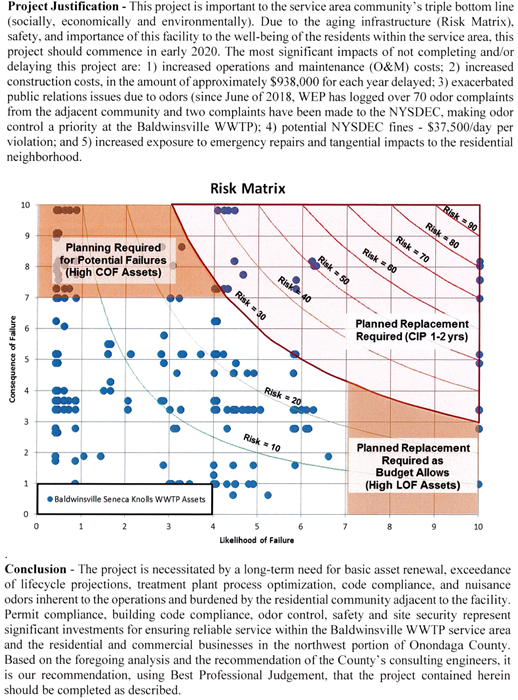
In answer to Chairman Jordan, Mr. Lannon said that odor was not a violation they could be fined for but they could strongly encourage upgrades and might get DEC Air involved.
- Collectively all agree it is time to pursue this project - 40 years old, real odor control concerns for neighbors
Mrs. Tassone asked if the funds for this project could be awarded in sections and how they determined the dollar amount of $938,000 for each year delayed. Mr. Lannon responded that it was 3% of the total construction cost assuming inflation. There are a lot of efficiencies in bundling the project and it makes more sense to have the same set of contractors. Also, collectively the different assets to be replaced all have the same need so the time is now. Mrs. Tassone stated that this is a lot of money. Mr. Lannon agreed. Mr. Mento said that it is all in one location so all contractors, subcontractors, and everyone will be mobilized and in sync from day one, which provides efficiency and a cost-enhancing element. To break the project into phases would require new contractors, new contracts, different times, and reestablishment of mobilization which doesn’t make sense.
In answer to Mrs. Tassone, Mr. Lannon said that construction would take roughly two years.
Mrs. Abbott-Kenan stated that the pictures are pretty compelling.
A motion was made by Mr. Bottrill, seconded by Mrs. Abbott-Kenan, to approve this item.
Chairman Jordan asked if the project would be EFC bonded. Mr. Lannon answered that it depends on how many points the project receives; various rubrics are used to identify points, all projects throughout the state are added to the list, hope to score high enough. Cannot say for sure but it is on their intended use plan; the final 2020 plan should be out in the next week or two.
In answer to Chairman Jordan, Mr. Lannon said that there is a huge difference in EFC funding, roughly half the rate that the county can get; about 1.7. There are some administrative fees but it is worth the effort to pursue
In answer to Mrs. Abbott-Kenan, Mr. Lannon confirmed that the assets are reaching their end of life.
Dr. Chase said that we have seen a few of these places like this, 40 years old and falling apart, and you wouldn’t let your house do that. Mr. Mento responded that the last 25-30 years have been predominantly focused on ACJ - lake cleanup, CSO work, and all that kind of stuff. Work has been done at various treatment plants and conveyances but not at the level it needs to be. With the shift away from ACJ oriented work, although it will still be there, there is an opportunity to get a much better handle on our assets; will shift into these types of projects because we need to.
Passed unanimously; MOTION CARRIED.
d. Adopting an Amended Schedule of Sewer Rents for the Onondaga County Sanitary District
Mr. Mento:
-
As part of the budget process looked at volume and unit charge, industrial unit reduced to 125,000 gallons of water usage; change affects about 5%-10% of the industrial client base
-
Generates more units to support our initiatives and restores some parity between residential and industrial users
-
Historically went from 146,0000 gallons to $135,000, now 125,000, will continue to decrease until there is complete parity
In answer to Chairman Knapp, Mr. Mento said the national average is around 60,000-75,000 gallons residential, industrial is slightly higher; 125,000 gallons is still a high number but it will come down over time. Chairman Knapp said that our unit is still well over the average.
Chairman Jordan asked the estimated impact of this change for the industrial user. Mr. Mento answered that he had two numbers in his head and did not want to give the wrong information; will get back to him.
In answer to Dr. Chase, Mr. Mento defined an industrial user as Crucible, WestRock, and anyone you would think of in terms of industry. Dr. Chase said that when this came up a couple of years ago those with mixed-use property would have been affected most. Mr. Mento said that this affects a portion of them but it is really insignificant; about 1.1 times. This has more of an impact on big water users like WestRock.
Dr. Chase said that this would now apply a charge for each apartment or residential area plus something for the commercial stuff. Mr. Mento responded correct, not sure of the exact ratios for the mixed-use scenario; 1 unit then ¾ unit for every other apartment unit.
Dr. Chase said that some say their commercial space doesn’t use any water. Mr. Mento said to keep in mind that this affects only 5%-10% of our base and taking it down in measures is the right thing to do. Dr. Chase agreed.
Chairman Jordan said that the sewer charge is based on the amount of water used. If an industrial user doesn’t use much water they should not be impacted. Mr. Mento responded that is correct.
2Mr. Bottrill left the meeting.
In answer to Dr. Chase, Mr. Mento responded that this charge will be billed in units and fractions of units based upon usage associated with the calculation. Dr. Chase said that this is cheap compared to the rest of the country and isn’t fair for residents to carry the load for industries.
Chairman Knapp asked if wastewater meters measure output or are the units based on some equation of what OCWA is sending in. In some cases, a lot of the water doesn’t go in the sewer, i.e. Budweiser. Mr. Lannon responded that in some cases there is an effluent flow meter and where isn’t the charges are based on water supplier records. Where needed subtractions are made for evaporation or use in the product.
A motion was made by Mrs. Tassone, seconded by Dr. Chase, to approve this item. Ayes: 4 (Knapp, Jordan, Tassone, Chase); Absent: 1 (Bottrill). MOTION CARRIED.
2. OFFICE OF ENVIRONMENT: Travis Glazier, Director
a. Authorizing the County Executive to Sign an Amended Intermunicipal Agreement Allowing for the County’s Continued Participation with the Central New York Stormwater Coalition
2Mr. Bottrill returned to the meeting.
Mr. Glazier:
Chairman Jordan asked if there was some type of reimbursement for the services provided to the other municipalities. Mr. Glazier answered that an MS4 agreement was sent out earlier this year which laid out WEP’s reimbursement rates for performing services. He then went on to provide examples of different stormwater services. Chairman Jordan asked it the rate was exact cost or an additional administrative fee on top of that. Mr. Glazier answered that WEP establishes the rate and he doesn’t know what is backed into the cost; he will ask Mr. Mento to provide the breakdown. As mentioned earlier, improving water quality that goes into the tributary from these MS4’s is a net benefit for WEP and the county. Again, that rate has already been sent out.
Chairman Knapp asked if this was just for towns within the sanitary district. Mr. Glazier answered that these are other MS4’s. Chairman Knapp asked if other outflows are part of this. Mr. Glazier answered yes; we get inspections as a result of this and we help with mapping. Chairman Knapp said that OCSWCD does a lot of the inspections. Mr. Glazier answered that they work through CNYRPDB to perform these services. The member municipalities are both inside and outside of our sewer district, some are outside of the county but it is a coalition and the goal is to consolidate a series of services, i.e. public information, mapping of all outfalls. There are a lot of economies of scale for the members who don’t have a problem paying for this.
Chairman Knapp said that he was on the Lafayette Town Board when this first came about and it was going to be a huge cost to each town as each would have to do their own engineering, surveying and such. All the towns came together with the county under County Executive Pirro to do this and it has saved the towns hundreds of thousands of dollars. This has been a great program. Mr. Glazier said that it has been very efficient for the member municipalities Chairman Knapp said that it is very popular with the towns. Mr. Glazier said that the impact would be tremendous for smaller municipalities.
Chairman Knapp said that there is a lot of paperwork. Mr. Glazier agreed; fortunate to have CNYRPDB to carry out this administration for the county.
A motion was made by Mrs. Abbott-Kenan, seconded by Mr. Bottrill, to approve this item. Passed unanimously; MOTION CARRIED.
Chairman Jordan adjourned at 10:16 a.m.
Respectfully submitted,

KATHERINE M. FRENCH, Deputy Clerk
Onondaga County Legislature
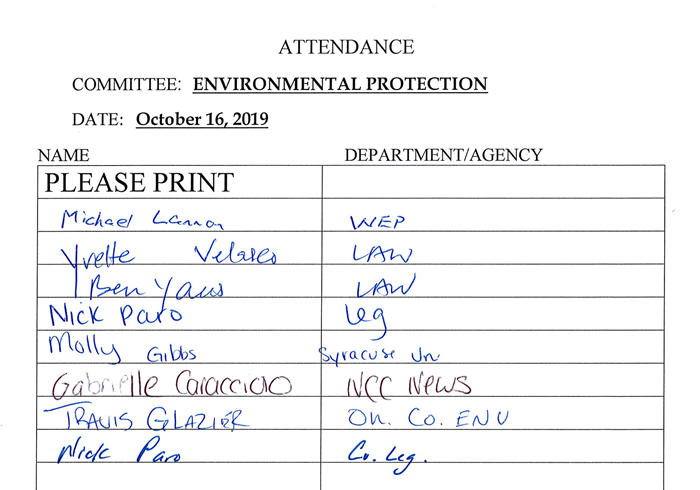
* * *
HEALTH COMMITTEE MINUTES – OCTOBER 17, 2019
TIMOTHY T. BURTIS, CHAIRMAN
MEMBERS PRESENT: Mrs. Abbott-Kenan, Dr. Chase, Ms. Williams
MEMBERS ABSENT: Mr. Bottrill
ALSO ATTENDING: See attached list
Chairman Burtis called the meeting to order at 9:33 a.m. A motion was made by Dr. Chase, seconded by Ms. Williams to waive the reading of the minutes of the previous committee meeting. Passed unanimously; MOTION CARRIED. A motion was made by Dr. Chase, seconded by Mrs. Abbott-Kenan to approve the minutes of the previous committee meeting. Passed unanimously; MOTION CARRIED.
1. Presentation: Building a Lead Safe Community
Katie Bronson, Home Headquarters
Debra Lewis, Program Coordinator for Health Department
Ken Towsley, Director of Code Enforcement for City of Syracuse
Martin Skahen, Director of Community Development
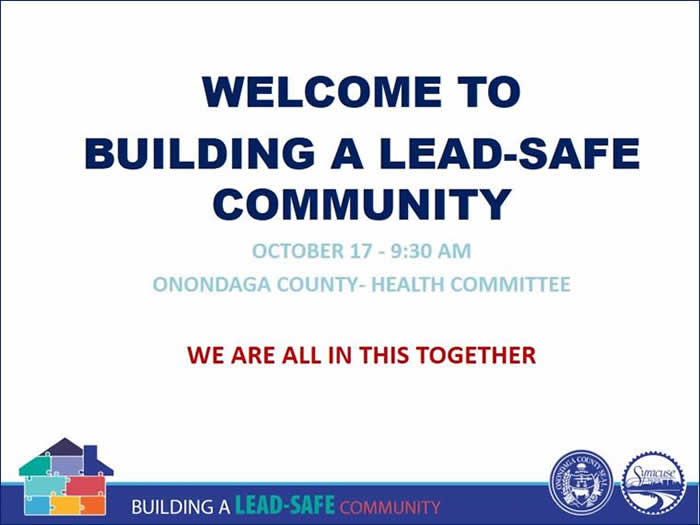 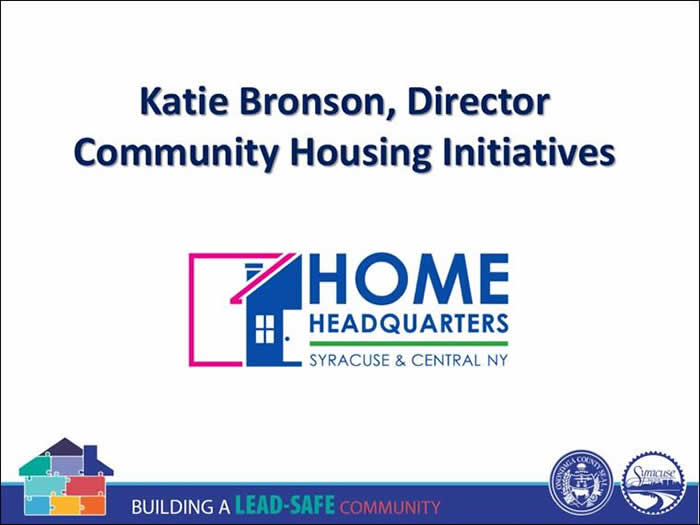

Ms. Bronson:
-
4 years ago, Home Headquarters (HH) became project administrator for Green and Healthy Homes Initiative, which addresses health, safety and energy efficiency of homes in Syracuse area
-
Topic that came up most with lack of financial resources is Lead - How can community make this more important, start identifying strategies and implementing them; created Lead Poising Prevention Action Plan

-
Federal – contractors and landlords have to address appropriately; most do not have the training; HH and city of Albany received funding to help contractors and landlords receive the training
-
Different ways for organizations/people to participate; one reason to have forums and community outreach
-
All need to take roll in lead poising prevention, (i.e.) HH – housing improvement programs
-
Health and medical field – get involved and understand they need to know what’s going on at home and work
-
Housing stock is very old, starting to deteriorate; cannot ignore condition of properties and amount of work to be done
- Key is ensuring a lead safe environment
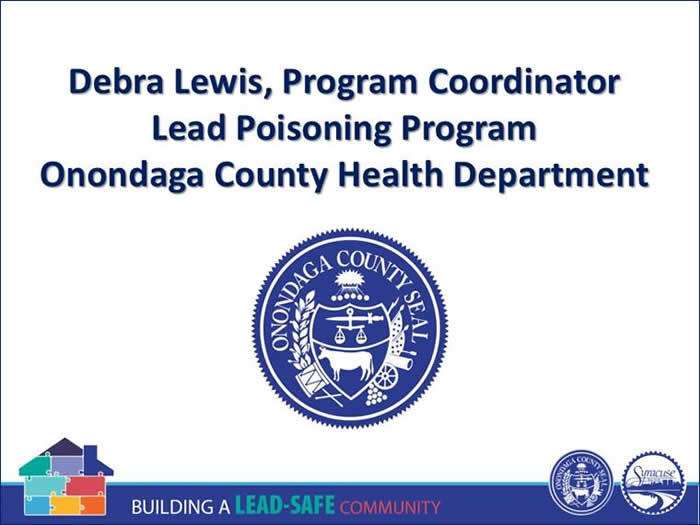 
Ms. Lewis:
-
Appreciate opportunity to be here; thanked committee for support of Health Department’s budget including additional staff for increased need with new state changes; legislators are ambassadors to administration and community
-
Lead Poisoning Prevention Week – being public about prevention in addressing child lead poisoning in community
-
3 messages Health Dept. and Lead program work to spread – get the facts, get home tested and get child tested
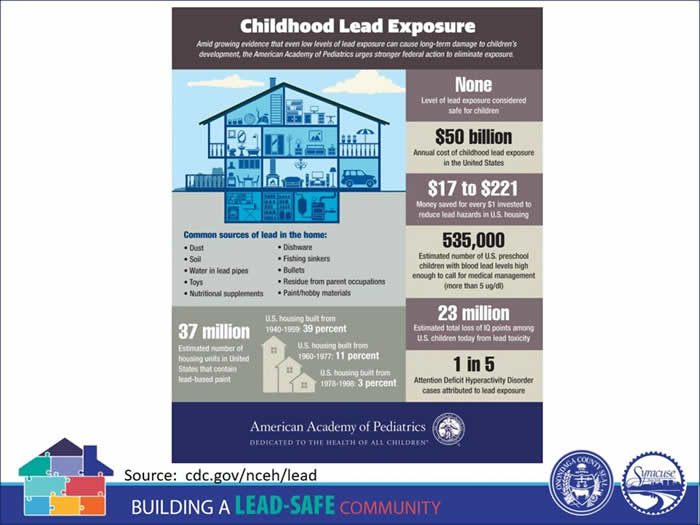
-
Impact on current reality and future health growth and development; not just individual health impact, but economic and social impact as well
-
Onondaga County could potentially save $62 mil in future costs for children born in 2018, if they never had elevated test results – cost savings include reductions in special education services, medical care and follow up services
-
Prevention would save time, health and money for children and families
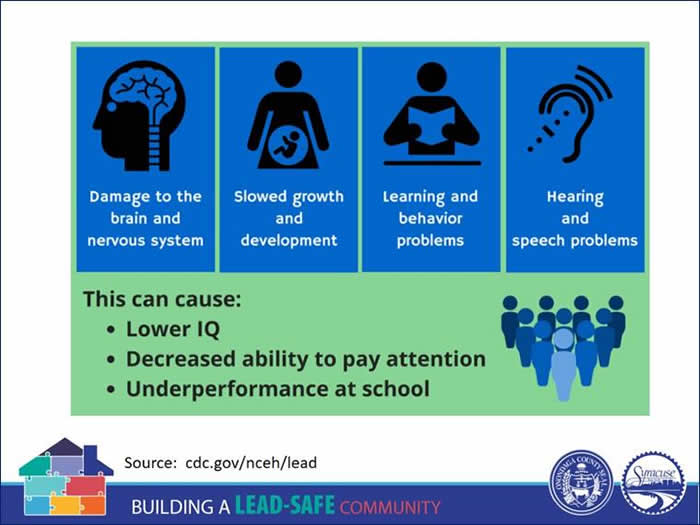
-
Early identification key – earlier they find elevated test result, then the earlier they can provide follow up services to check growth and development; can make sure any needed services are implemented
-
Testing at age 1 and 2 a requirement of NYS Code Health Law; every medical provider must provide testing and follow up services as indicated by test result; first line in child health care
-
In 2017, 90% of children lead tested by primary care doctor; in 2018, it was 94% throughout the County
-
Requirements for providers increasing, as well as interaction between providers and Health Department – ensure services provided in way required, documenting care provided and in the loop for referrals needed on behalf of family
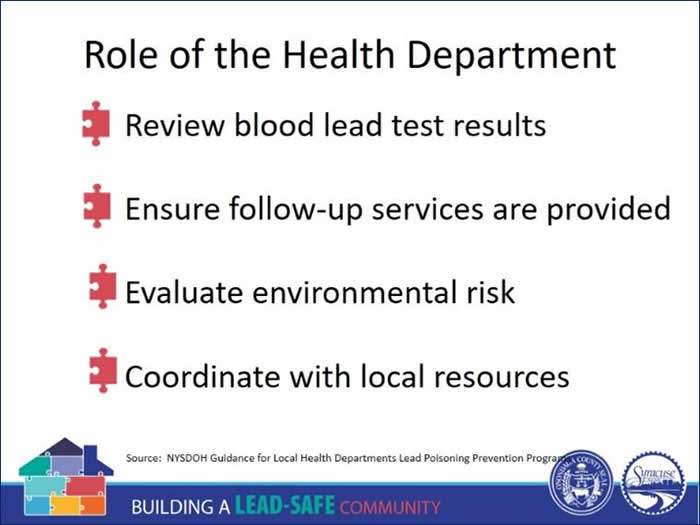 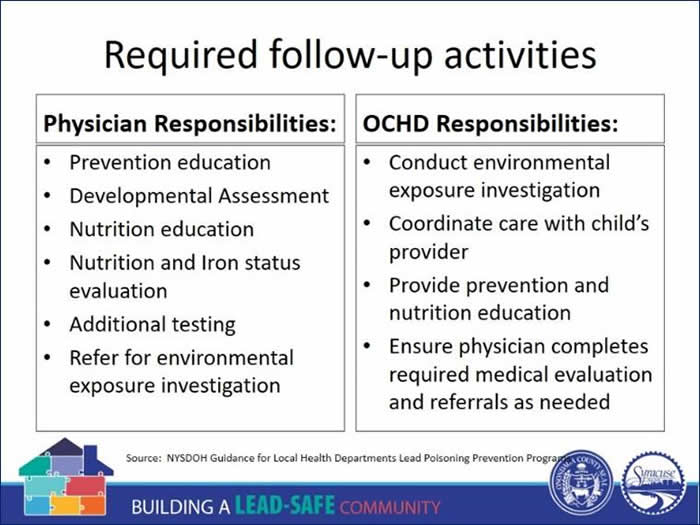
-
Lead Testing Registry - Health Department uses to accept responsibility for every test for Onondaga County children; determine follow up services for children with elevated test results
-
State Immunization Registry – providers look at their own performance; evaluate children who might need testing; used to assess local performance in testing (low performance providers)
-
Care Coordination Team touches everything including schools – assessment of what’s happening with family, are children enrolled in school, are they being tested in a school based health center, are they doing okay in school, etc.
-
Based on reporting by parent to intervene – (i.e.) transportation issue; connect family to resources they need
-
Only one Care Coordinator, and soon will have two to help provide more detailed services
-
Oct 1st - new requirements for providers and Health Department – families need to understand how to minimize risk in their home environment; what inspection will find, and what happens next
-
Provider offers comprehensive assessment of child health, growth and development; child receiving medical intervention needed and connected with appropriate referral sources
-
Health Dept. provides referrals to Help Me Grow; assists family with accessing services in community to better meet needs; if family in-between doctors, no insurance or difficulty getting in, try to connect with resources to fit child’s needs
-
Test result threshold of 5 micrograms per deciliter increased caseload
-
Providers responding to change of regulations very proactively; lot of communication with NYSDOH – ensure everyone bringing up what need to do internally and comply with new regulations
-
NYS – issuing communications through NYSIIS (Immunization Registry)
-
Percentages rising with clean up for accurate reflection of what’s happening statewide
-
Health Dept. invited to practices servicing most difficult to reach families to provide presentation and overview to clinical staff explaining new regulations, and help understand how to be in compliance to ensure children are receiving services
-
NYSHD – local lead experts preparing grand round to physician community to bring up to speed on who’s who in Lead; rolls and responsibilities; make sure children receiving appropriate care

- XRF Lead Inspection - can read through layers of paint to find lead; deteriorating paint is hazardous
-
Inspectors good at getting in touch and staying in touch with owners regarding plans to remediate hazard; sharing resources in community; ensuring people working on properties are trained and certified; scheduling timeline
-
Health Dept. - own performance measure to evaluate how well they are doing with getting owners to comply
-
Goal to make sure in less than years’ time that everything seen in original inspection is corrected
-
87% compliance within a year; shorten timeframe of inspection to compliance in 2020 (can be affected by weather)
- Next benchmark for compliance is within 9 months
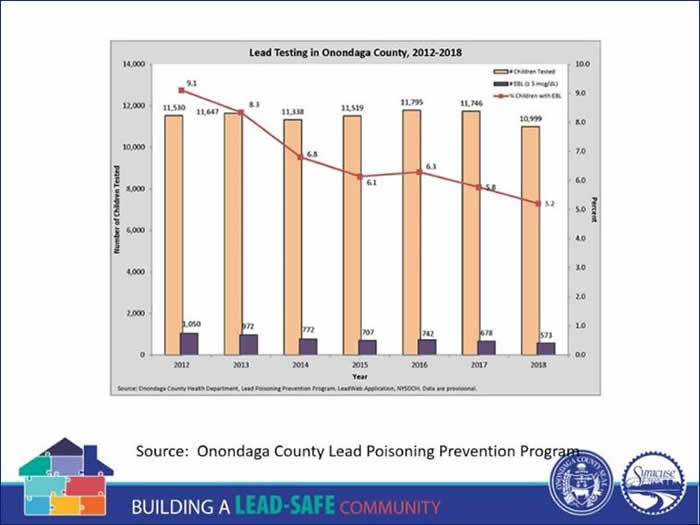
- NYSIIS data – local data reported annually to Onondaga County showing test results and trends; following national and statewide trends; it is falling
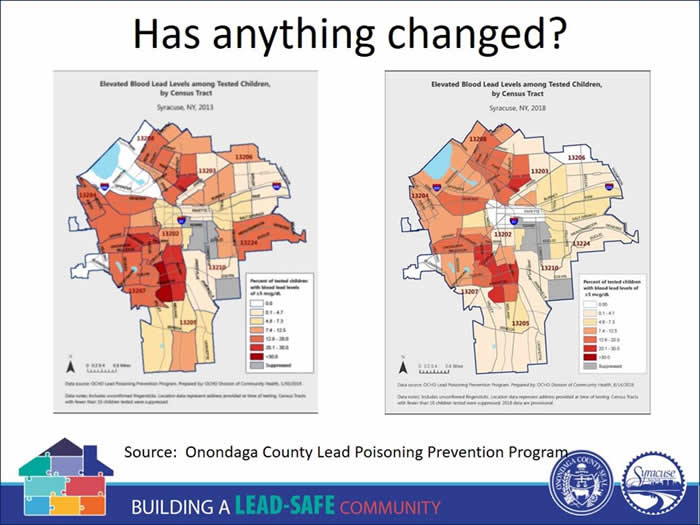
-
2013 map shows darker coloring, which is higher test results; 2018 on right not as dark - children still identified in those same areas, but the test results are not as high; improvement, but more work to do
-
Every inspection Health Department does goes into City’s database; City knows if there was a lead inspection, if there are hazards, or if a case is open or closed
-
Health Dept. uses database to see if person applied for rental registry; inspector checks home, already know if owner has complied with rental registry; if lead hazards, will notify code enforcement, and rental registry application begins
-
Meet with City to review cases and lead violations for next steps
-
Preventive investments in housing goes long way to improve value, health and happiness; reducing exposure to toxins
-
Areas of focus are not all in City, but they are not at level of those in City; includes properties in older towns and villages
-
More than 85% of homes are in the City
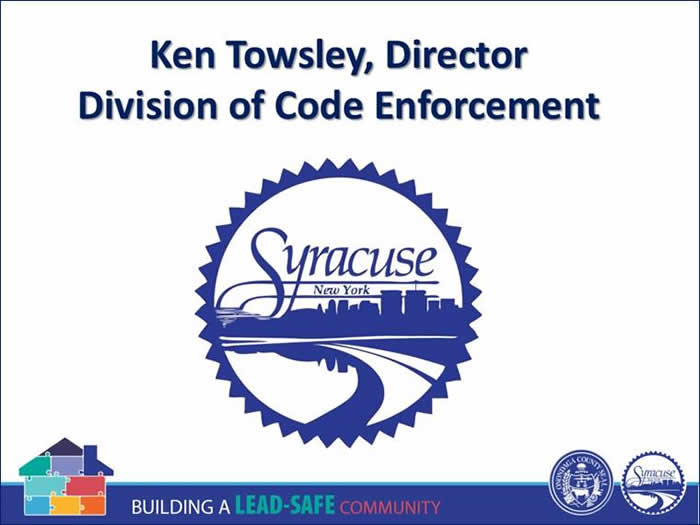 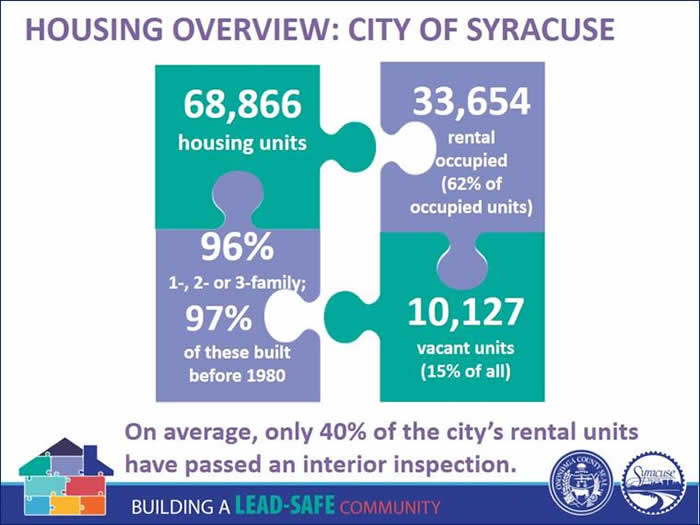
Mr. Towsley:
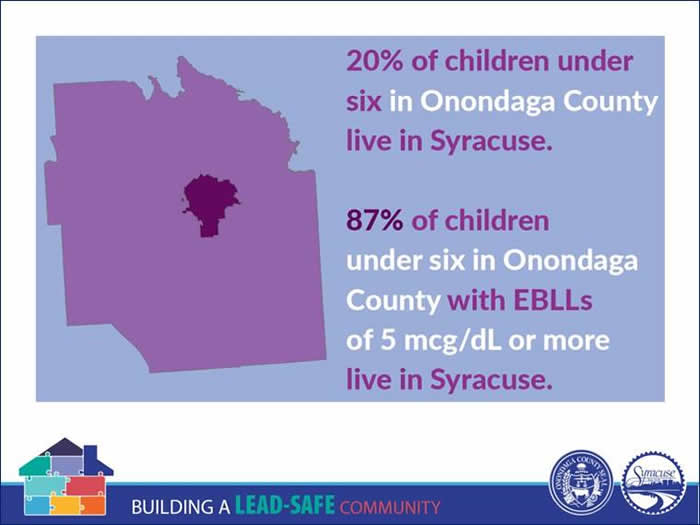
- City of Syracuse based on age of housing; major issue in city; working with County to fix issue
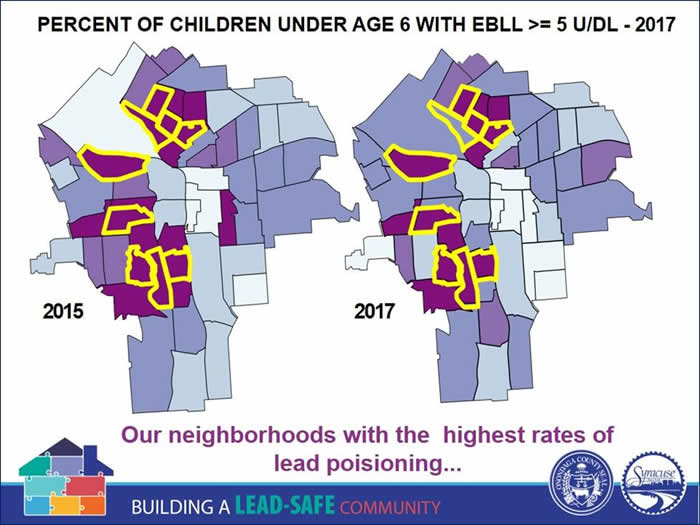
- High concentration of children with high EBL levels
- Complete overlay with code violations and DSS recipients; landlords not addressing
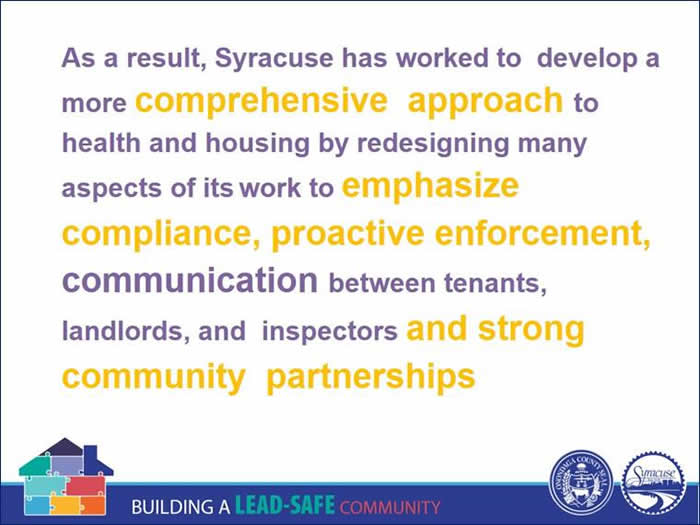
- Reach out to all parties involved; previously would cite and walk away from property, waiting for property owner to contact City
-
Set forth to be proactive – (i.e.) receive call, then call landlord to see if they are aware, is tenant aware, is property manager aware; give opportunity to fix it
-
Month of September had 454 open code complaints, and 92 of them were addressed by landlords in 48 hours
-
Being proactive and opening doors, means a higher compliance rate; huge positive impact from landlords in last 2 years
-
Calling multiple times before compliant date goes a long way with landlords, when previously they would write up violation and send letter, then wait; cases could sit for years
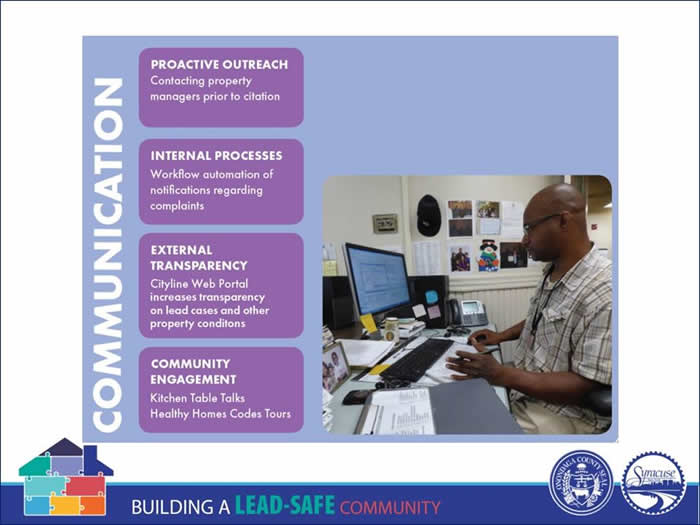
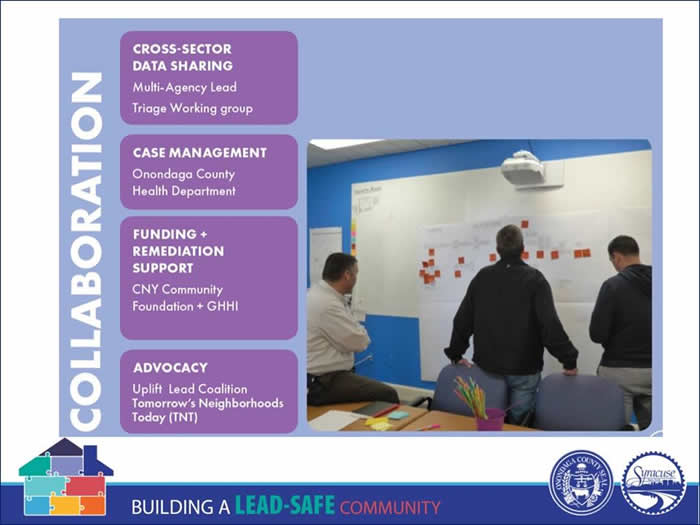
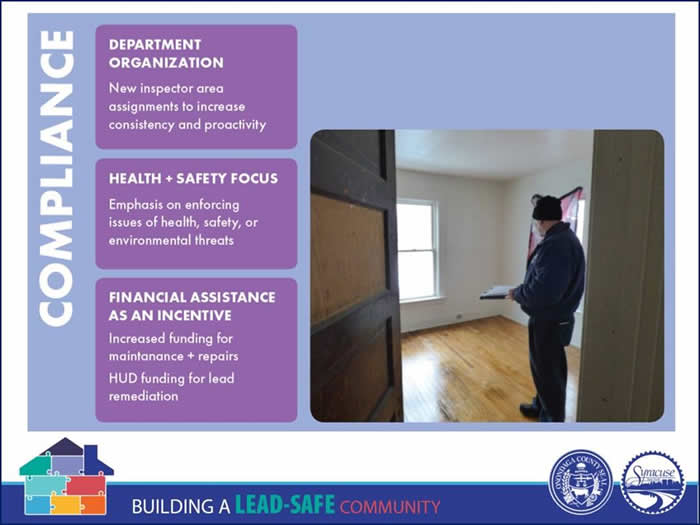
- Lead task force meets monthly with people from DA’s Office, Lead Dept., Health Dept., NBD, Code Enforcement Office
-
No ordinance that deals with existing lead paint; only ordinance is not using lead paint, but it is being addressed, as ordinance in process of environmental impact currently
-
City is quad based system – want to break City into 21 geographical locations; each location has 650 structures required to be inspected – vacant properties, rentals (1 and 2, or 3 plus) and/or businesses; some areas larger than others
-
Based on 3 year timeline – inspector has small piece of city and will be engaged with property owners, engaged with community and anyone else willing to help
-
Keeps a property in inspector’s hands; gives landlords ability to speak to 1 inspector (versus dealing with 3 or 4 inspectors over a 2 year period)
-
Violations that can lead to death that need to be addressed - (i.e.) smoke detectors, carbon monoxide, chipping paint (inside or outside), operating windows, proper ventilation
-
Health and safety violations are being pushed – if landlords understand, they will fix them in a more timely manner
-
Grants County and City received in lead abatement and remediation – give paperwork to landlords
-
Started performing HUD inspections in January; HUD asked Code Enforcement to do web based training for lead visualization; 12 inspectors and supervisors took training and can visually see lead, but still cannot write it up; will share information with County to get the right people to do the testing

-
Seeing uptake in applications and ticketing through Bureau of Adjudication; finally up and running April 1st this year; taking cases and ticketing; huge impact
-
Last year sent 1,000 letters to neighborhoods saying they need to apply for rental registry; 35% compliance
-
Landlords that did not apply, in violation and ticketed; as of yesterday at 82% compliance
-
Lead ordinance – hopefully by July 1st, 2020 will have lead ordinance with more teeth
-
Bureau of Adjudication - started with rental registry, and seeing high compliance; then went to interior and exterior violations, and started having hearings; landlords not happy with upwards of $2,500 in tickets for violations
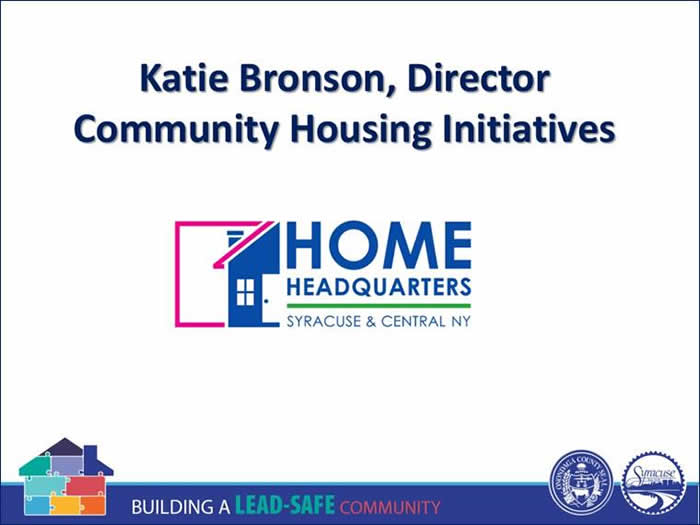 
-
Next step of identifying how to improve housing stock; make sure addressing and testing house; programs available
-
Syracuse Landlord Program – address properties in City by addressing lead hazards and code violations; specific to landlords, because that’s where most lead hazards are; plus it is hard for them to find financing
-
Purchase and Rehab Program – does not specifically address lead
-
Training available for landlords and contractors - required to have 8 hour training and certificate totaling $460, if addressing lead based paint in rental units; education piece and encouragement to be aware of resources
-
Funding for that provided by CNY Community Foundation - received last year, opened in December, closed in January
-
Awarded second round funding, and will do more towards winter for training
-
Windows and Doors Program – friction surfaces; funding to address, because that is where high cost is for lead hazard reduction; will see chipping and peeling paint, as well as dust
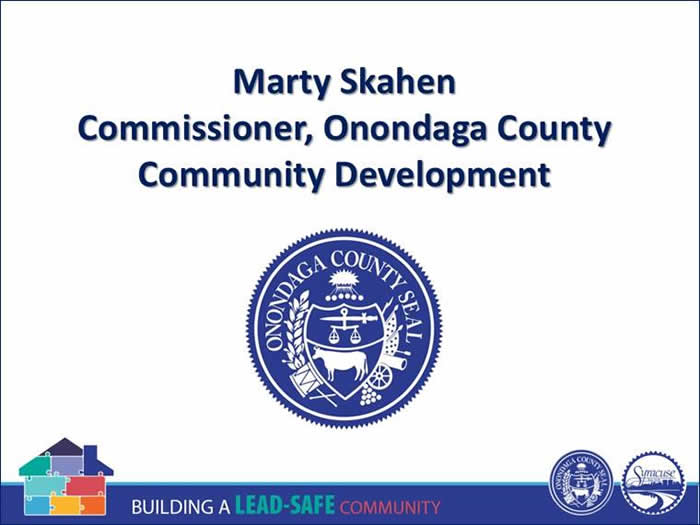 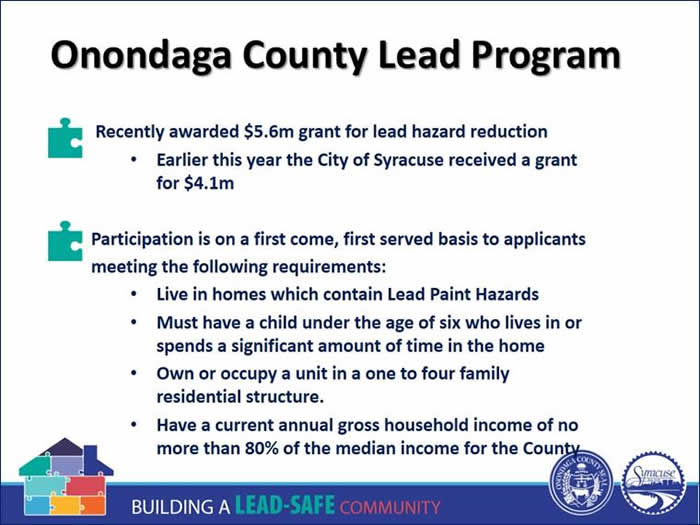
Mr. Skahen:
-
City received funds from HUD this week; put 10 jobs out the door; 42 months to spend $10 million
-
Income based on who is living in unit; (i.e.) multimillion dollar landlord with 40 properties, and they have a low income family in unit that has lead, then that unit/family qualifies
-
Once qualified, Community Development team does all work scheduling time to test, determine what work has to be done, bid out work, secure contractor and will oversee work with contractor until done
-
If there’s a child with an elevated blood level in a unit, their application goes to the top, versus one without a child at risk
-
Send inquiries about lead directly to Mr. Skahen, because there are other programs available
-
Lead work has certain dollar amounts they can spend without going to HUD; Community Development will match other funds from federal government or state

Chairman Burtis said this is important, and this is a great program.
Mrs. Abbott-Kenan asked how many landlords take advantage of the Landlord Program, and Ms. Bronson responded that there has been a lot of interest in the program. People get sticker shock when they see how much lead is in the home, and how much it will cost. In reality there have been projects with challenges due to costs. HUD funds up to $25,000 per unit, but many times it goes over that. If there is not another resource to help, then it is hard to implement.
Mr. Skahen agreed with Dr. Chase that there are a lot of old houses in villages that people might not think about. A lot of the housing stock was built before 1978. Up until 2015, the grants received, previous to the City losing their lead grant, were spent outside the City.
Ms. Lewis asked if it is still true that a property can only be served once by a HUD grant. Mr. Skahen replied that he is not sure if that’s the lead grant requirement, or how it has been worked. Ms. Lewis recalls that a property can only receive assistance for lead reduction once.
Chairman Burtis thanked everyone for coming. He stated that this is a very important issue that needs to be continuously monitored, and as Legislators, they need to stay involved with this worthy cause.
The meeting adjourned at 10:21 a.m.
Respectfully submitted,

JAMIE M. McNAMARA, Assistant Clerk
Onondaga County Legislature
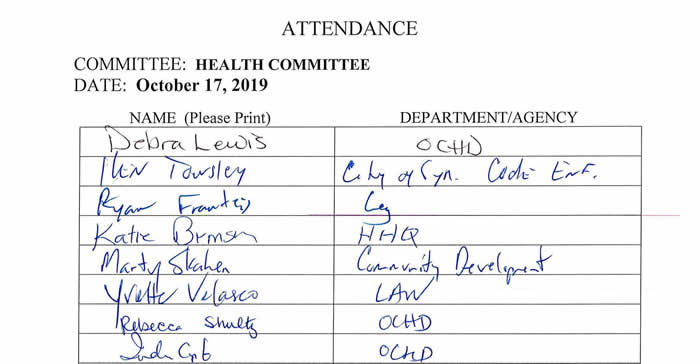
* * *
PLANNING & ECONOMIC DEVELOPMENT COMMITTEE MINUTES – OCTOBER 17, 2019
JOHN D. McBRIDE, CHAIRMAN
MEMBERS PRESENT: Mr. Holmquist, Mrs. Abbott-Kenan, Mr. Burtis, Mr. Buckel
ALSO ATTENDING: Chairman Knapp; see attached list
Chairman McBride called the meeting to order at 10:33 a.m. A motion was made by Mr. Burtis, seconded by Mrs. Abbott-Kenan, to waive the reading of the proceedings from the previous committee. MOTION CARRIED. A motion was made by Mr. Holmquist, seconded by Mr. Burtis, to approve the minutes of the previous committee meeting. MOTION CARRIED.
1. SYRACUSE ONONDAGA COUNTY PLANNING AGENCY: Dan Kwasnowski, Director
a. Adopting the Onondaga County Multi-Jurisdictional Hazard Mitigation Plan Update
Mr. Kwasnowski:
- Plans intent is to reduce the liability of known hazards, i.e. storms, flooding, ice; new additions are infestations and harmful alga blooms (HAB’s)
- Infestations cover ticks, tick-borne diseases, and invasive species, i.e. emerald ash bore
- Otisco and Skaneateles Lake are two large water sources affected by HAB’s
- The City of Syracuse has already submitted 2 projects for FEMA funding:
- $266,000 for Onondaga Creek Flood Risk Reduction Phase 1 – Arsenal Park Flood Storage Study
- No dollar amount yet to extend the drinking water intake for Skaneateles Lake
In answer to Mrs. Abbott-Kenan, Ms. Costa confirmed that the amount is unknown as the letter of intent was due Tuesday and they didn’t have enough time to get a copy for this meeting.
In answer to Mr. Kwasnowski, Ms. Costa said that the county has applied but hasn’t been awarded funding through this program in previous years. However, there is a lot more interest now that people are familiar with what the program is and the funding opportunity.
-
Multi-jurisdictional portion of the plan is most important as each municipality would have had to do this on their own if not done as one - definitely the preferred way for doing this
-
Cost about $300,000 - $225,000 from feds and $75,000 in-kind to update the plan for 5 years
-
Includes participation from 34 of 35 municipalities, Onondaga County, and OCWA
-
Significant level of coordination and partnerships; received accolades from NYS for the level of participation in the workshops organized by SOCPA
-
New hazards added are not new to Onondaga County but are fairly new overall; NYS is interested in how this will work out
-
Update includes all the new standards set by NYS
-
Over 100 projects identified: planning, education, policy, construction
-
April 2019 draft plan finalized by the Steering Committee and planning partnership
-
August 2019 reviews completed and approved by NYS DHSES and FEMA
-
Over half of the municipalities have adopted the final plan
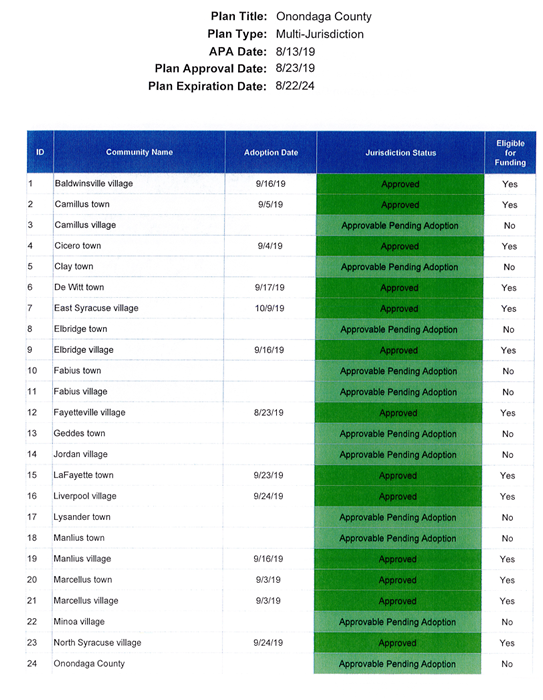 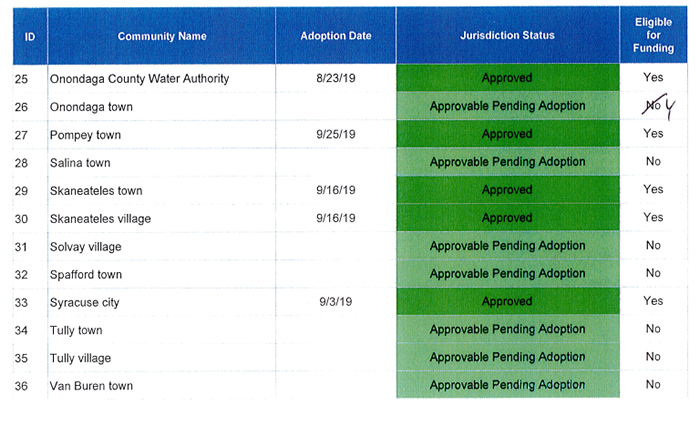
- Town of Onondaga approved last night; met the need of over 50%
-
Other entities interested in applying for projects include OCSWCD, Environmental Health, and the Towns of Spafford, Marcellus, and Skaneateles
- Next step is county consideration for adoption
In answer to Mr. Buckel, Mr. Kwasnowski said that the plan is required by both the feds and the state pre-existing Homeland Security. The Disaster Mitigation Act of 2000 dictates hazard mitigation planning should occur and the state has been pushing for it to occur at the county level. Mr. Buckel said that funding depends upon plan completion and approval. Mr. Kwasnowski agreed.
Mrs. Abbott-Kenan stated that she has recently been approached about a HAB Action Plan and asked if it could potentially fall under this plan for funding. Ms. Costa responded that it is listed as one of the posted actions. Several actions around the HAB issue were thrown under this plan. She is not sure if it would be super competitive under the big FEMA plan but having it well documented in the plan as a hazard in a community helps bring in other planning sources that may be around. Mrs. Abbott-Kenan said that Spafford applied under FEMA before. Mr. Kwasnowski said that it was probably under something different.
Chairman McBride asked if there was a deadline for municipality approval. Ms. Costa responded that FEMA considers the plan done and approved once the first municipal approval is received and reimbursement can be received once 50% have approved. Both of those thresholds have been met but to be eligible for funding it needs to be approved. Mr. Kwasnowski said that technically a municipality with a project that hasn’t approved the plan could then approve the plan and apply for funding.
Chairman Knapp said that with the large July storms several years ago the Towns of Spafford, Lafayette, and Pompey, had significant damage and applied for FEMA but didn’t get anything; questioned if the approved plan will make it easier to apply for things such as that. Ms. Costa answered that she believes so as within each municipality’s chapter all damages and vulnerability are documented whether it raises to the level of FEMA declared disaster or not. Mr. Kwasnowski said that he thinks the key to receiving funding is planning for issues and not reacting. Mrs. Abbott-Kenan said that nobody could have planned for the storm Chairman Knapp mentioned. There are still roads closed, condemned homes, and etcetera so they have been trying to retroactively apply for engineering reimbursement. Ms. Costa said that it was post-disaster and this is pre-disaster. Taking care of issues before disaster hits so that it isn’t impacted as opposed to recovery efforts.
In answer to Chairman McBride, Mr. Kwasnowski confirmed the complete plan can be seen online @ http://ongov.net/planning/haz/2019UpdateDraftPlan.htm
A motion was made by Mr. Holmquist, seconded by Mr. Burtis, to approve this item. Passed unanimously; MOTION CARRIED.
b. Calling for Publication of the Notice of Eight-Year Review of Agricultural District No. 2, Towns of Skaneateles, Marcellus and Spafford in Onondaga County
- Properties can be added or subtracted during the 8-year review
- Pushing to make it more accurate, will try to get it as close as possible; as seen last year, people try to use it for unintended uses
Mr. Buckle said that within this review they will try to access not only the geographic outlines but the specifics within. Mr. Kwasnowski answered that if the property has been converted to subdivision we work with the town and landowner to remove it. However, he is sure that anyone’s issue with agriculture will come up in this process. It is a good district with a lot of farms.
Chairman Knapp stated that this basically starts the process. From here the Farmland Protection Board meets to review applications to add or delete property, and property can only be deleted during the 8-year review of the district. The board does a great job and as you may remember, last year a parcel did not justify being part of the district.
Ms. Costa stated that every landowner in the district will receive a December mailing from the legislature and the Farmland Protection Board. Chairman Knapp said that Ms. McNamara handles that process. She the clerk for the Farmland Protection Board and does a boatload of work as part of this process.
In answer to Mrs. Abbott-Kenan, Ms. Costa said that public notice will also be sent out and posted in municipalities and sent to the partners to let people know that they can enroll. There is also a survey that goes to all farmers in the community to try and get a picture of the state’s agriculture.
Ms. Costa:
-
Also will be doing press for a new round of funding for NYS Farmland Protection Grants; opening our pre-application process through the Farmland Protection Board, letters and outreach going out this week with a December deadline
-
There is a new dairy transition round - the state is trying to help struggling dairy farms; regular round anticipated for spring of next year too
-
About to hit the 10,000-acre mark for protected farmland
Mr. Kwasnowski said that he will be back next month to request acceptance of funds for updating the Farmland Protection Plan. Chairman Knapp said that the Ag Counsel is part of this. Local farms have done very well with Farmland Protection Grants and the support staff at Cooperative Extension and SOCPA have been incredibly involved in helping these projects. It is a good thing; a farm in Pompey was just awarded $2 million for protection and it is in an area that is being developed.
A motion was made by Mrs. Abbott-Kenan, seconded by Mr. Burtis, to approve this item. Passed unanimously; MOTION CARRIED.
Mr. Kwasnowski thanked the committee for their support during the budget process. As you can see from the Multi-Jurisdictional Hazard Mitigation Plan Update the match SOCPA provides is very important and having another staff person for GIS work will allow us to do more.
A motion was made by Mr. Burtis, seconded by Mr. Holmquist, to adjourn the meeting at 10:54 a.m. MOTION CARRIED.
Respectfully submitted,

KATHERINE M. FRENCH, Deputy Clerk
Onondaga County Legislature

* * *
WAYS AND MEANS COMMITTEE MINUTES
OCTOBER 29, 2019
DEB CODY, CHAIR
MEMBERS PRESENT: Mr. Rowley, Mr. Jordan, Mrs. Ervin, Mr. Ryan, *Ms. Williams, **Mr. May
ALSO PRESENT: Chairman Knapp, Mr. Bush, see also attached list
Chair Cody called the meeting to order at 9:03 a.m. A motion was made by Mrs. Ervin, seconded by Mr. Jordan, to waive the reading and approve the proceedings of the previous committee. MOTION CARRIED.
*Ms. Williams arrived at the meeting.
1. SYRACUSE ONONDAGA COUNTY PLANNING AGENCY: Dan Kwasnowski, Director
a. Adopting the Onondaga County Multi-Jurisdictional Hazard Mitigation Plan Update
Mr. Kwasnowski:
-
Plan took 1.5 years
-
Two chapters added: Harmful Algae Blooms and Infestations
- Identifying as a hazard makes for eligibility for mitigation funding
- City is looking for funding for Skaneateles Lake to protect the water source
- Infestation – invasive species including ticks and Emerald Ash Borer
-
Other chapters are as usual: severe storms, flooding, etc.
-
Every town village in county has their own chapters, which talk about what their needs are; includes OCWA as well
-
Cost of plan approx. $300K - $230K grant with $74K in-kind provided by SOCPA staff
-
Plan goes through 5 years
-
20 of the 35 local communities have adopted this plan – need over half to make it official and to get reimbursement
Mr. Jordan asked to be provided with a 1 or 2 page document of the changes that were made. Mr. Kwasnowski said that the addition of the 2 new chapters is the biggest update. The rest is updating the data, maps, etc. Ms. Costa said that each community identified new projects to take up, projects and that have been completed – have added about 50 projects to the list, 100 projects in total defined. Each have added profiles, updated all project lists, updated vulnerability analysis, and added the two new hazards. Mr. Kwasnowski said that it is also on the SOCPA website.
Mr. Rowley asked if it is anticipated that the other municipalities will adopt a plan; are there issues or pushback. Ms. Costa said that they all participated very actively; it was a requirement of FEMA adopting their portion that they show that they participated in the planning process. At this point, they have done all of the work; they just have to do the final legislative adoption. No substantial push back is anticipated. Mr. Kwasnowski said that if they want to adopt the project, they will have to adopt the plan first.
Mr. Rowley referred to a WHEREAS clause relative to SEQR, noting that it is an exempt activity, and asked if that is different than a negative declaration. Mr. Yaus said that exempt is Type II, which typically you don’t get the negative declarations.
Mr. Ryan asked if all of the towns and villages would have to go through SEQR declaration. Mr. Kwasnowski said that the plan itself does not, but the individual projects would. Mr. Yaus said that if the county is approving any funding, we too would join in on that requirement as well.
A motion was made by Mrs. Ervin, seconded by Mr. Jordan, to approve this item. Passed unanimously; MOTION CARRIED.
2. WATER ENVIRONMENT PROTECTION: Frank Mento, Commissioner; Mike Lannon, Deputy Commissioner
a. Authorizing the Execution of a Settlement Agreement with Atlantic States Legal Foundation Regarding the Amended Consent Judgment (ACJ)
Chair Cody stated that the agenda would be taken out of order; item 2a would be moved to the end of the agenda.
b. A Resolution Calling a Public Hearing in Connection with Proposed Improvements for the Onondaga County Sanitary District ($2,020,000)
Mr. Mento said that items 2b and 2c are part of the CIP – looking into next year – they are two significant projects that we will need to bond for--have been part of the plan for some time in design and thought.
Mr. Lannon:
- Combined sewer overflow abatement project – CSO 029 on Walton Street
- Most highly act
- Install a primary regulator to have more a direct route to the main interceptor sewer
- Install a 24” pipe from the regulator to the MIS
- At times there would still be overflows – would come down the 36”, then overflow 29 into Onondaga Creek
- Install a new secondary regulator – a new chamber with an adjustable weir preventing Onondaga Creek from coming back into the sewer, which has happened at times
- Had a similar circumstance at Clinton Storage facility where flat veils were installed to prevent the Creek from coming back in; this is just a different approach to that with using the adjustable weir
- Collectively, this project would improve the hydraulics, and more importantly, reduce the amount of CSO overflows into Onondaga Creek
- Construction mid-year, next year; will take roughly 12 months
ive CSOs – overflow about 40 times/year
- Designed to reduce frequency of overflows down to 4-6 – combine with federal CSO policy and state mandates
Mr. Lannon provided a graphical/visual explanation of the improvements and what currently occurs during an overflow:
Mr. Jordan said that right now we are at 97.7% capture, and asked if this project would move that up a little bit. Mr. Lannon said that it would certainly improve things, but did know exactly how much. He explained that there are several different criteria that the federal government has. One is an overflow frequency of 4 – 6; we are meeting the capture rate at a very high rate, but there is another set of criteria that has to be met as well and this would address that.
Mr. Mento said that this is in the heart of the city so steps are being taken to coordinate very effectively with the city government, engineers, etc., to make sure it goes as smooth as it can. Chair Cody noted that this is right in the middle of Armory Square. Mr. Lannon agreed, noted that it is just a block up from the MOST; it is a challenging location. In answer to Chair Cody, Mr. Lannon said the construction will be roughly a year.
Mr. Jordan asked if there are water lines or other things in that area, that while we have it open, it would be wise to replace or address. Mr. Lannon said that there certainly be other infrastructure there and may have to make improvements in that regard as well. Mr. Mento said that it is suffice to say that there is everything in there. As we dive into the details, we will bring in the water department, and other folks to the extent we can leverage our work with theirs, we will – we always do that. Mr. Jordan said that to the best of his knowledge, we haven’t done any work specifically in this area, so there wouldn’t have been any repair work on water lines or anything based on any prior projects.
Mr. Ryan asked if the street had to be closed down for a year. Mr. Lannon said that those details are still to be worked out, but hopefully not; ideally we would have at least one lane open. Mr. Mento said that it is the intersection itself that is the most critical area – will have to devise a maintenance protection plan to make sure flow is still effective through the intersection. Even though it’s a year-long project, the actual work itself in the intersection – the critical area, is probably 2 – 4 months. As we get outside of that on some of the side streets, it doesn’t get as crazy and busy.
Mr. Jordan said that he assumes that part of it will be coordinated opposite with the Landmark. If you are working on the road and the Landmark has a tractor trailer or two parked on Clinton Street, it could be extremely problematic in terms of traffic flow.
Mr. Rowley asked how long has this been on the radar screen; the overflows are described as pretty significant. He said he doesn’t know how projects are ranked for priority. Mr. Lannon said that it has been in the queue for quite some time as far as a master listing – something we knew we had to address. Regarding prioritization, the first step was addressing those other large CSOs – Midland, Clinton, Harbor Brook, and then it’s a measured approach to eventually get to this one. There were higher priorities addressed first, and now are embarking on this one.
Mr. Jordan asked what the average life expectancy if for these projects; Mr. Mento said it is 50+ years. In answer to Mr. Rowley, Mr. Morgan said that we would typically bond for 20 years.
A motion was made by Ms. Williams, seconded by Mr. Ryan, to approve this item. Passed unanimously; MOTION CARRIED.
c. A Resolution Calling a Public Hearing for the Purpose of Considering an Increase in the Estimated Maximum Cost of Proposed Improvements for the Baldwinsville Treatment Plant ($31,280,200)
Mr. Lannon:
- Phase 2 ancillary renewal project
- Largest of 6 treatment plants – built in 1982 – a lot of equipment is original to the plant – 37 yrs. old
- Project is based on a comprehensive facility assessment done by a consulting engineering firm – looked at all the equipment, building, all assets and then identified various project buckets of 5 yr., 10 yr., 20, yr. and then prioritized them accordingly
- In a position to pursue an immediate bucket – 5 yr. – rehab needed for proper operation of the treatment plant and SPDES compliance
- Will provide a much needed odor control
- Components of the project:
- Replace influent screens with finer mechanical screens – takes out more of the material that comes into the head works of the plant--will have less stress on downstream treatment process
- Replace influent pump system
- Replace original belt filer process with new technology—used to dewater sludge
- Replace aerated chamber blowers at head works of facility – removes grit, supplies dissolved oxygen to wastewater
- Replace variety of different pumps
- Odor Control:
- Replace original mixing system covered digesters Nos. 1 & 2 – are getting and incomplete process there now – emissions are more odorous than they should be; new, improved mixing will complete that process and reduce odors
- Significantly expand odor control system – close residential area and neighbors have been very sensitive to the odors
- Architectural, code compliance, structural upgrade
- Renovate locker rooms and bathrooms
- Repair deteriorating concrete – it’s down to rebar in some aeration tanks
- Various site/safety improvements including eyewash and safety shower compliance, carbon monoxide alarms, installation of fire monitoring system
- Construction cost estimate of approx.$30 million, and also seeking $1 million for next phase of asset renewal – design for replacing mechanicals with primary and secondary clarifiers
- Collectively $31,280,200 construction and engineering total
- Concerns/exposure of not doing or delaying the project:
- Increased construction cost – inflation value of 3% could equate to $1 million
- Logged over 70 odor complaints from neighbors, some have been registered with DEC as well
- Exposure of DEC fines of up to $37,500/day
- Risk Matrix – catalog all assets, evaluate them in terms of likelihood of failure, consequence of failure – multiply to identify the risk for a given asset; prioritize them and try to address high risk ones – has been very successful
In answer to Mr. Jordan, Mr. Morgan said that the bonding would most likely be 20 years.
Mr. Rowley asked what happens to the sewage during construction. Mr. Lannon said that they will only take out part of the plant – there is a lot of redundancy where we have multiple trains. We can take out one train and leave the other one in operation. We will be at a reduced capacity in some regards, but it is always the goal to keep everything in service to the extent we can. It’s part of the process – downgrade a little while under construction.
Mr. Rowley noted that this project does not increase capacity, and asked if the capacity of this plan is adequate. Mr. Mento said that it is as best as it can be. There is capacity potential and given the surrounding development that has all been considered in what we need to do. At this time, it makes sense to upgrade the plant this way – there is probably more capacity at this plant than in other ones.
Mr. Mento said that as we start to move away from the ACJ components of the lake, this kind of physical asset work at plants and conveyance structures becomes more paramount. He said we have to start going back and looking at the assets and evaluating them. This is the start with an important project and timeline.
Chairman Knapp noted that a few years ago, a lot of Camillus was diverted away from Baldwinsville to Metro to give Baldwinsville more capacity.
Mr. Bush asked if the capacity issue could be addressed a little clearer for growth. He noted that that area of the county is really starting to take off; it’s a bright spot for economic development in the county and there is some concern about capacity. Mr. Bush noted that capacity is not being addressed with this $30 million project. Mr. Mento agreed, and said that he can report back to Mr. Bush with the exact numbers. He said that there is definitely more capacity at this plant, which includes considering the open lands for development, as factored into what we need. He will get the exact numbers which will show what the average flow is a on a daily basis and what the limit is. Mr. Bush said that we are hoping to redevelop the Syroco site; it would be sad if we end up in a situation where we don’t have capacity to handle the economic growth. Mr. Mento said “that is not going to be the case for this plant.”
A motion was made by Mr. Ryan, seconded by Ms. Williams, to approve this item. Passed unanimously; MOTION CARRIED.
d. Adopting an Amended Schedule of Sewer Rents for the Onondaga County Sanitary District
Mr. Mento:
- Amend the schedule of sewer rents to accommodate a volume reduction
- Going from 137,000 gallons equal to one unit down to 125,000
- A reduction in volume that equates to a few more units that will aggregate into the mix of units
- Puts us on parity and gets us closer to what residential users would use as part of a whole unit analysis
- Typical residential user is in the neighborhood of 75,000 to 90,000 gallons/year +/-; industrial users are at 125,000 with this adjustment – this is slowly paring it down and trying to get the two to be more equivalent
- It just affects the industrial users within the community and creates more units to work with
Mr. Jordan asked if there are any estimates for the increased revenue. Mr. Mento said that the increase in revenue is about $3.5 - $4 million.
A motion was made by Mr. Ryan, seconded by Mrs. Ervin, to approve this item. Passed unanimously; MOTION CARRIED.
3. OFFICE OF ENVIRONMENT: Travis Glazier, Director
a. Authorizing the County Executive to Sign an Amended Intermunicipal Agreement Allowing for the County’s Continued Participation with the Central New York Storm Water Coalition
-
IMA to participate in the Storm Water Coalition, managed by CNYRPDB
-
Since 2012 the county executive has included $3,600 in the budget for participation in this
-
Reauthorization of county participation because a few changes were made to the bylaws and process – changed some voting procedures in that if they don’t have a quorum they can still get enough votes to make decisions
-
Has been a very successful partnership between the county, local municipalities, and CNYRPDB
Mr. Rowley asked if all municipalities participate. Mr. Glazier said that it is only small MS4s – amongst those he thinks that all are participation only small MS4s – amongst them all are all participating. Some of our communities don’t have an MS4 – the population is too low, i.e. Otisco. There are a couple outside of the county that participate, as it is technically multi-county.
Mr. Jordan referred to a WHEREAS clause and asked if we are providing those services in lieu of our share of $3,600, or are we providing those services as well a paying $3,600 into the collation. Mr. Glazier said that the clause is saying that the Coalition provides the services for $3,600. Mr. Yaus agreed and added that the county would essentially be paying the equivalent or more if we hadn’t been going through CNYRPDB. It is really just having a centralized economies of scale doing all the work for all of the municipalities, which brings up the cost a little bit, but streamlines the process. Otherwise, the county would have to do this on its own; this allows CNYRPDB to do it on our behalf.
Chairman Knapp said that this has been going on for some time. Those that came from town boards may remember that this was truly and under the radar, unfunded mandate, that came down from NYS to all the towns to identify all of these areas, at their own cost, come up with engineering plans, do annual inspections, improvements, etc. For a little town like LaFayette, it was going to cause a tax increase just to cover this. All of the towns coming together and working with the county on this has really spread out the cost. Soil and Water contracts with CNYRPDB to do the outflow inspections – it’s a nice collaborative effort and a great story, and a great deal for $3,600. If towns were on their own, it would be thousands and thousands of dollars just to cover engineering costs, etc. Mr. Glazier said that it removes duplication of services.
A motion was made by Mrs. Ervin, seconded by Mr. Ryan, to approve this item. Passed unanimously; MOTION CARRIED.
4. BOARD OF ELECTIONS: Dustin Czarny, Michele Sardo; Commissioners
a. 2019 Transfer:
From Acct. 694080 Prof. Svcs. to Acct. 693000 Supplies & Matls., $3,500
From Acct. 694080 Prof. Svcs. to Acct. 694100 All Other Expenses, $5,000
From Acct. 694080 Prof. Svcs. to Acct. 694100 All Other Expenses, $14,000
-
3 transfers all coming from fees for services – all within BOE budget
-
Saved in Fees for Services by eliminating vote referral system because of going to electronic poll books, Sage Smith reporting and Clear Ballot software for extra scanner were put on SHOEBOX grant
-
$3,500 Supplies & Matls. – for labels and other materials that we are not sure what will be covered in the Aid to Localities Grant; did not have the contract with NYS at the time of putting together the transfer; have since received contract and believe that some of the costs will be covered by the grant
-
Had to buy labels and seals that were not anticipating when the budget was made because early voting was not passed at that time
-
$2,000 for trucking – bid came back higher than the previous costs – shipping equipment to and from different polling places on election day; there is more equipment now than there was before; not sure of amount and felt it was better to have a little bit of a surplus in there
-
$14,000 due to new rules for bulk mailing in NYS has increased the cost; more registration this year than previous this year; tracking that it will be higher and maybe higher than presidential election 2016; have 8,000 new voters in Onondaga County that in 2016; a trend that there was no way of predicting
-
Believe they will continue to remain on or below budget for 2019
Mr. Jordan asked if we are going to a paperless voting system, he is not sure why office supplies are going up. Mr. Czarny said that it’s not necessarily for the poll books themselves, it is for the seals on the voting equipment. By law have to have a paper poll book in every polling station – it’s condensed – it’s in case the poll books go down. It cost much less to print that. The shortfall in office supplies and materials is mainly due to the transfer of our electronic poll books – have 400 cases to ship out and make sure they are not opened by the time they leave BOE and Election Day. We believe it will be covered by the Aid to Localities Grant, so the money may not be spent, but want to make sure there is not opportunity to do this after the election before the end of the fiscal year.
Mr. Rowley asked what the savings is with the move to electronic poll books. Mr. Czarny said they are saving about e $30K in printing, and a little bit at the print shop. There is a savings of 75 inspectors, which is about $15,000. Currently in the 103 line, there is about $330K left and expect to spend about $280K. Mr. Rowley asked if it is safe to say that going forward that there will be a budget reduction in professional services. Mr. Czarny said, not next year as it is a presidential year with 3 different elections and have increased staffing next year. He said that if this works this year, and next year with some of the reduced staffing, we should be able to see some reduction.
Mr. Ryan thanked the commissions and their staff for putting a lot of hours related to early voting. He noted that the increased voter registration wasn’t anticipated.
A motion was made by Mrs. Ervin, seconded by Ms. Williams, to approve this item. Passed unanimously; MOTION CARRIED.
5. INFORMATION TECHNOLOGY: Kevin Sexton, Chief Information Officer
a. Amending the 2019 County Budget to Make Funding Available for Use in Connection with a Grant from the U.S. Department of Justice Bureau Statistics, and Authorizing the Execution of Agreements ($731,682)
-
Grant addressed the FBI mandate for all law enforcement agencies to become NIBRS (National Incident Based Reporting System) compliant
-
Reporting by incident type information and more specific data elements that comprised the actual crime itself
-
Includes 58 data types and 52 offense types – more data to collect to allow better targeting certain types of crimes
-
In order to become compliant there needs to be a number of programing changes and how data is collected
-
CNY Leads is an old police reporting application; this will render that application obsolete – an old, clunky application running on an unsupported application framework; state funding allows incorporating into CHAIRS 2 application,
-
2 other components of the grant: Syracuse Police Dept. and Manlius Police Department were invited to submit costs to upgrade some of their technology – the county submitted the grant on their behalf
-
Manlius Police Dept. will receive $62,725 mainly for mobile computers for the cars and for MiFis to connect; SPD will receive $256,957 for upgrades for mobile computing and wireless applications
-
$408,000 will be used for application development to collect appropriate data, put in business rules, edits, introduce electronic signature for the approval path of police reporting, and ability to submit NIBRS compliance reports
In answer to Mr. Jordan, Mr. Sexton confirmed that the grant covers all of the cost of the changeover.
Mr. Rowley asked if it is spent all up front and we get reimbursed or is money provided upfront. Mr. Sexton said that it will be in a project account and will be submitted for reimbursement periodically – probably quarterly, based on any costs that were incurred at the point. Most of the cost for application development are going to be for consultant fees.
Chair Cody asked how Manlius Police Department was included. Mr. Sexton said that he does not know how they were selected; the committee that was awarding the grant reached out to the directly.
Mr. Jordan asked if the consultant that will be implementing this has been hired, or will it go out to bid. Mr. Sexton said that a mini bid was up out on it already.
Mr. Rowley referred to the project manager noted in the work plan and asked if that is a new FTE or the consultant. Mr. Sexton said that they are going to absorb part of that; the consulting services are going to provide some of that as well. There will be some internal coordination with IT staff to make changes to the application, which the consultant will do.
A motion was made by Mr. Rowley, seconded by Mr. Ryan, to approve this item. Passed unanimously; MOTION CARRIED.
6. LEGISLATURE: Linda Ervin, Minority Leader
a. Confirming Appointment of John DeSantis as Legislative Aide of the Onondaga County Legislature (Sponsored by Mrs. Ervin)
- Have been without someone since Mr. Butler left; ask that Mr. DeSantis be appointed to fill that spot
- The resume has been provided
A motion was made by Mrs. Ervin, seconded by Mr. Ryan, to approve this item. Passed unanimously; MOTION CARRIED.
7. FINANCE: Don Weber, Director, Real Property Tax Services a. 2019 Transfer:
From Acct. 641010 Reg. Employee Salaries to Acct. 694080 Prof. Services, $15,600
- Increased cost for tax collection program
- Have had more buy in from local towns, villages, school districts than anticipated – created shortfall
- Vendor charges monthly; county absorbs the cost for towns, village an school tax collectors - $150/month
**Mr. May arrived at the meeting.
Mr. Jordan asked if this the program where in theory everyone will be on the same real property tax system and information will be available more/less immediately. Mr. Weber said that was correct; the mainframe went away – either had to write our own program or get a vendor supported program. At that time a decision was made that since everyone has to collect taxes, we might as well look at getting one where we can all use the same program. It was offered to the towns and villages that if the county absorbed the cost, would they use it. As soon as somebody makes a payment, it is available on line. Mr. Weber added that 12 of 15 villages, 11 of 19 towns, and 10 of the 24 school district collectors are using it; the City of Syracuse will come on line in January.
A motion was made by Mr. Rowley, seconded by Mr. Jordan, to approve this item. Passed unanimously; MOTION CARRIED.
b. Monthly Report - Double Encumbered Positions (Res. 86-2018) – Steven Morgan, CFO

- There are a couple of new ones that are not anticipated to be on for long: MEO1 and Laborer 1
- The rest of the positions were taken care of the 2020 budget, except for process server
- The process server will be on-going – occupying 1005 of the position – 2 people sharing that position
Mr. Jordan asked if these positions are really being eliminated on January 1st or is it just that there are new positions created. Mr. Morgan said that when the positions become available at the start of the year, which were created in the budget cycle, those people will come out of the double encumbered positions and move into their own position.
8. SOCIAL SERVICES – ECONOMIC SECURITY: Sarah Merrick, Commissioner
a. 2019 Transfer: From Acct. 661010 Safety Net to Acct. 693000 to Supplies & Materials, $195,000
- Heard from NYS on Oct. 3rd that they were going to be pushing Windows 10 and the department is operating with Windows 7
- The state is pushing quickly because Microsoft will no longer support Windows 7
- There are approximately 900 county employees required to be on the state network to do their job
- Had less than 3 weeks to test the equipment and see what would work with the upgrade; everything but 257 scanners, purchased approximately 7 years ago, no longer work
- The State told us that they will not support these any longer – need to quickly purchase 257 scanners
- Started 8 yrs. ago to get rid of paper, i.e. DSS Temporary Assistance application is 26 pages long – a client has to fill it out
- Instead of putting it in a file and sending it to Rockwest, everything is now scanned up to the state electronic records
- Slowly getting rid of hard copies, but have to have the scanners to do the job
- Expect 70% reimbursement form the state; maximum for the purchase will be $58,000 local
Mr. May asked about the migration to Windows 10; Ms. Merrick said that the state does all of that. Mr. May said that it is just the peripheral equipment that has the compatibility issue. Ms. Merrick agreed. She said that the state will do it before the end of the year, so they are under the gun.
Mr. Jordan said that with basically eliminating paper, will all of that be held on the Cloud or on a server in Albany. Ms. Merrick said “Albany” – the state took on an electronic recording system – all counties are using it to basically get away from physical storage of all the paper that is required to collect. It is not just the application; have to collect pay checks, landlord forms – a client’s file is very thick. A good job is being done putting it onto the state’s filling system, but need the equipment to do that. Mr. Jordan said that he would imagine that there is a great deal of financial information, social security numbers, etc., and every day we hear about large, multi-national corporations where someone hacked into their system and all information gets out to the public. Ms. Merrick said that this is the state’s system, and it is why they need to move quickly from Windows 7 to 10 – to prevent malware and all of that information held hostage. It is the state’s responsibility to protect from hackers. Mr. Jordan said that he is not critical of what the county is doing at all; he is highlighting what he feels is a very realistic risk with the whole direction the state is going in.
A motion was made by Mrs. Ervin, seconded by Ms. Williams, to approve this item. Passed unanimously; MOTION CARRIED.
2. WATER ENVIRONMENT PROTECTION: Frank Mento, Commissioner; Ben Yaus, Senior Dep. Co. Attorney
a. Authorizing the Execution of a Settlement Agreement with Atlantic States Legal Foundation Regarding the Amended Consent Judgment (ACJ)
Mr. Mento:
- Bringing a structured settlement with ASLF, plaintiff in federal lawsuit for Onondaga Lake and ACJ
- History: done a lot of work over past 25 years; spent a lot of money cleaning up the lake, tributaries and City’s CSO problems
- At a point where ASLF, DEC, and WEP recognize that it is a time to move to the next phase of the process
- ASLF has spent 10 months negotiating with the county and are ready to execute the federal oversight
- DEC is fully on board with this – recognizes the same thing the ASLF does
- Signature moment – put this behind us and move forward with the next phase
Mr. Yaus:
- Exciting new step and really from the investment form this committee, this legislature, a commitment from WEP, and our predecessors; have reached a turning point
- Thanked everybody for the collaborative effort
Mr. Jordan asked if the county is still party to the same lawsuit, or does it mean that the county and DEC are still in it, so to speak, but like every other county in the state, we have responsibility to DEC unrelated to what was the currently pending litigation. Mr. Yaus said “both”. He added that the county will always have the same obligations as a county to DEC, but DEC is a party to the ACJ settlement agreement, as is the state AG and ASLF. Mr. Jordan said that the lawsuit itself is going to be settled – basically coming to an end – the only thing that will continue will be our otherwise, normal, everyday involvement with DEC. Mr. Yaus agreed; he said that the county still has to petition the court to get out of the ACJ. He explained that this agreement won’t end the ACJ, but will clear the way for the county to petition the court for ACJ. DEC support has been received and are hopeful the court will approve as well after 30 years. Mr. Mento said that it basically ends the federal oversight.
Mr. Ryan asked when we can say that we are done; we are at 97.7% there – is it up to the judge to drop the lawsuit and then the county is no longer held liable under that lawsuit of violating the Clean Water Act. Mr. Yaus said that the continuing issue is tributary compliance; there is a provision in the ACJ. All grey requirements, green requirements, CSO capture has been met; have built everything within construction deadlines – have done a great job there, but there is a fairly broad clause in the ACJ that says you have to meet water quality in the tributaries. In Harbor Brook and Onondaga Creek there are bacteria issues, largely unrelated to county sources. The issue is that without this settlement and just a permit dealing the tributaries and CSOs with DEC, we are still under the ACJ framework. This is ASLF saying “you guys have done a great job under the ACJ; you really can’t do anymore, diminishing returns under this structure; we are going to drop any arguments we have regarding tributaries that remain under this agreement.” DEC is on board as well, and that clears the stage to go to the court and say” all of the parties of this litigation agree; we’ve met it”. It’s then for the court to say “this litigation is now over.”
Mr. Mento said that DEC will not release us from the second condition, the water quality standard. They are saying “because of the broad clause within the standard, there is more work that you can show as a community – we want you to do that work.” Mr. Mento said that work is called a “Long Term Control Plan.” It is the agreement with DEC going forward. Once down the road with the work 5 – 7 years, then there is enough data to say that the county wants a variance – that it has been proven further that the county can’t get that water quality standard and DEC has enough meat on the bone to be able to issue a variance. Mr. Ryan said that he would think after 5 years, a lot of time and effort, it would be nice to say that we are out from underneath it. Mr. Mento explained that that what is described here is what every CSO community across the nation goes through. Storm water capture is usually met; tributary compliance is usually very tough to meet on many different levels, and they all try to seek a variance through a long-term control plan. The variable is how long and how deep.
Mr. Jordan said that this is resolving the ACJ; that the portion of the ACJ that deals with the tributaries is being taken care of with the Quality Control Agreement with DEC. Essentially, we are away from the ACJ; now just obligated to the DEC under the Quality Control Agreement. Mr. Yaus suggested entering into executive session because this involves ongoing litigation and a proposed settlement.
9 LAW:
a. Settlement of Claims
A motion was made by Mr. Jordan to enter into executive session to discuss pending litigation in the matter of Atlantic States Legal Foundation Et Al. v. Onondaga County and to discuss that matter on an attorney/client basis, and to discuss pending litigation in the matters of de Mascio v. Onondaga County and JB v. Onondaga County, seconded by Mr. May. Passed unanimously. Motion CARRIED.
A motion was made by Mr. Jordan, seconded by Mr. May, to exit executive session and enter regular session. Passed unanimously; MOTION CARRIED.
Chair Cody stated for the record that no motions or actions were taken during executive session.
Mrs. Ervin moved to adjourn the meeting at 10:30 a.m.; seconded by Mr. Ryan. Passed unanimously; MOTION CARRIED.
Respectfully submitted,

DEBORAH L. MATURO, Clerk
Onondaga County Legislature

|



















































